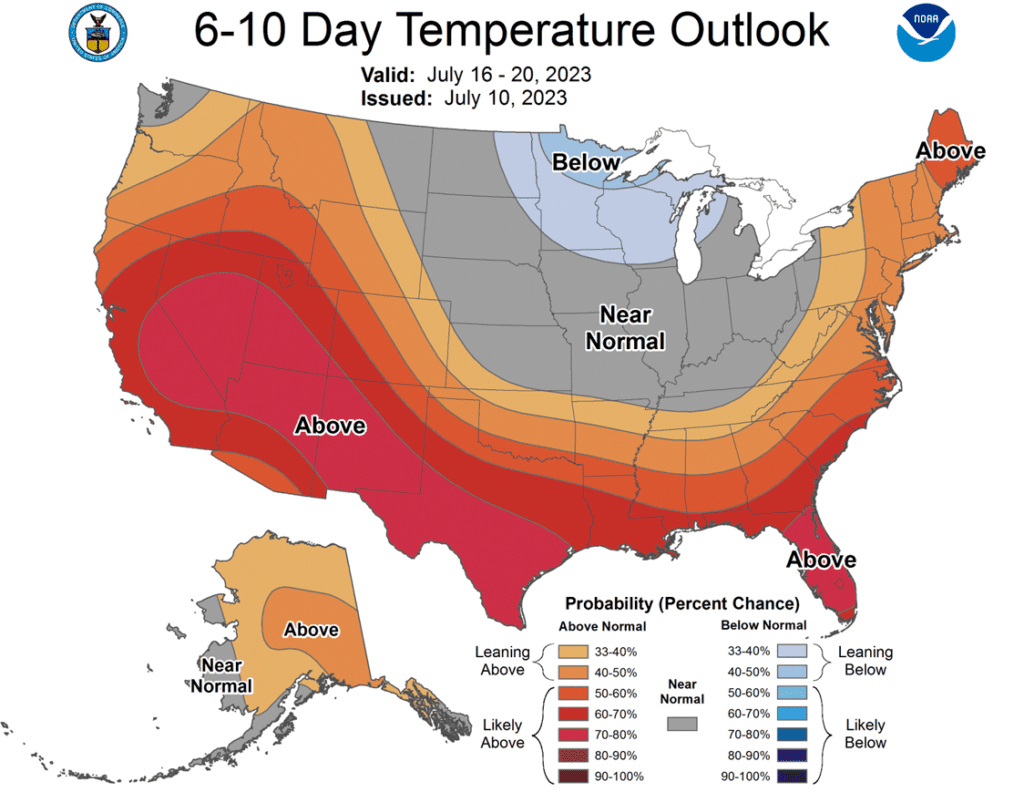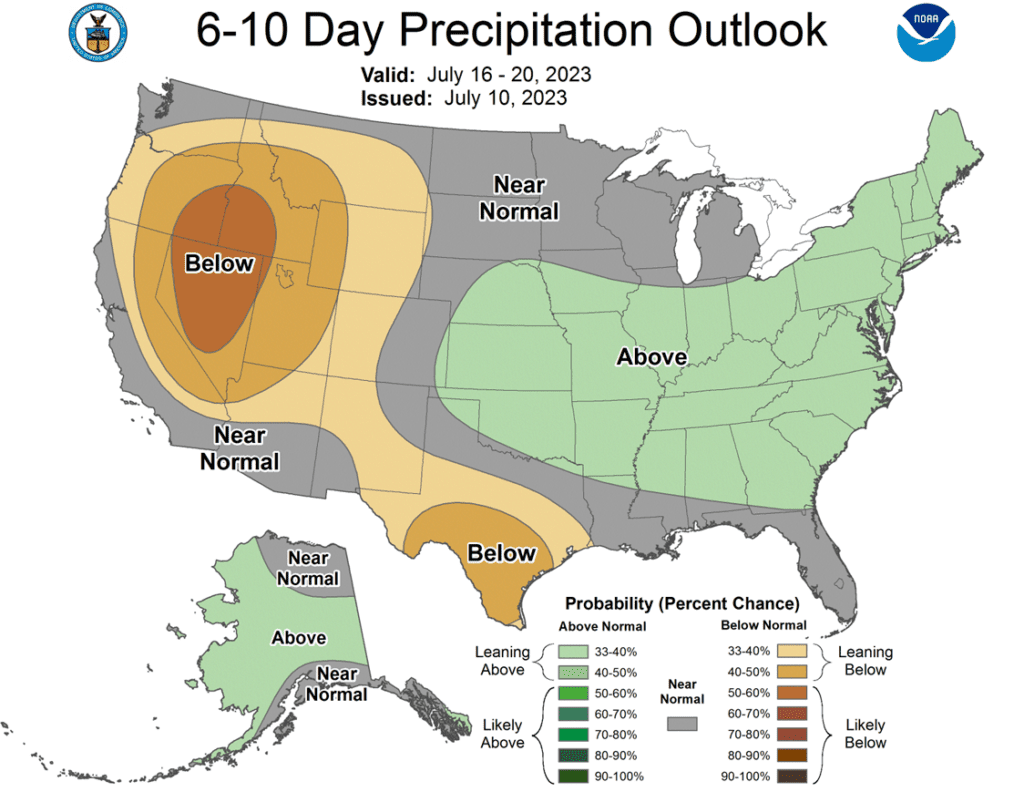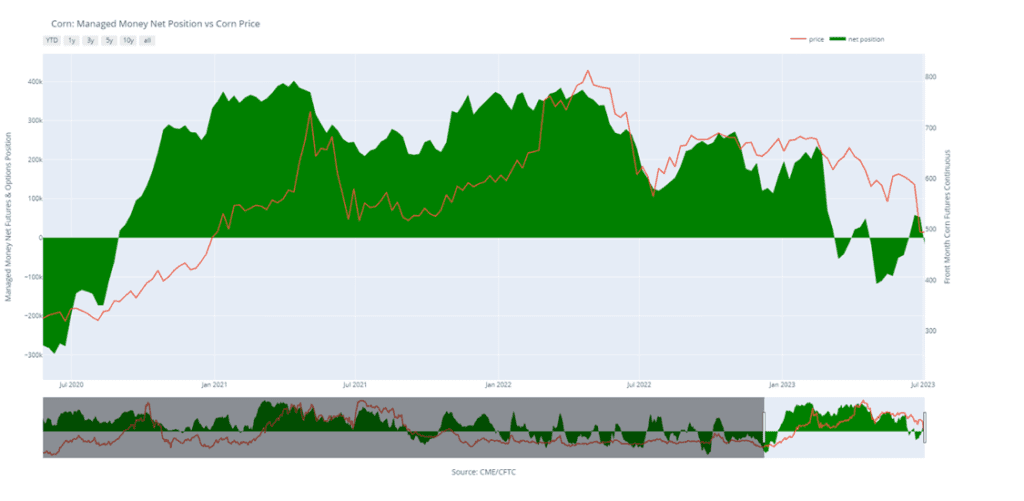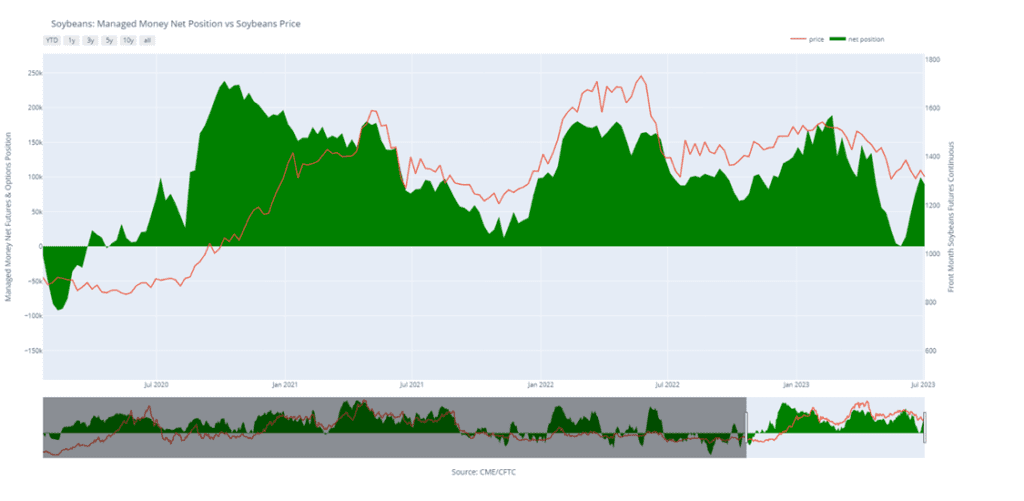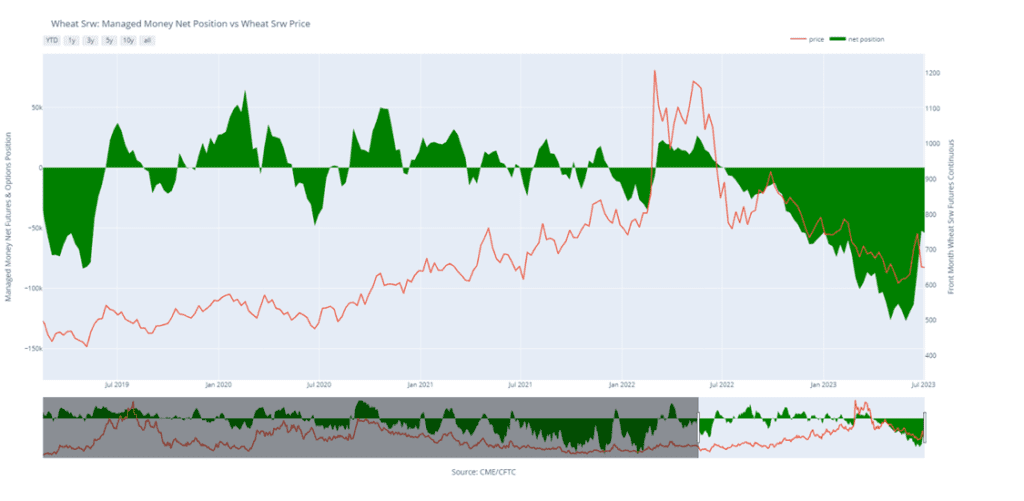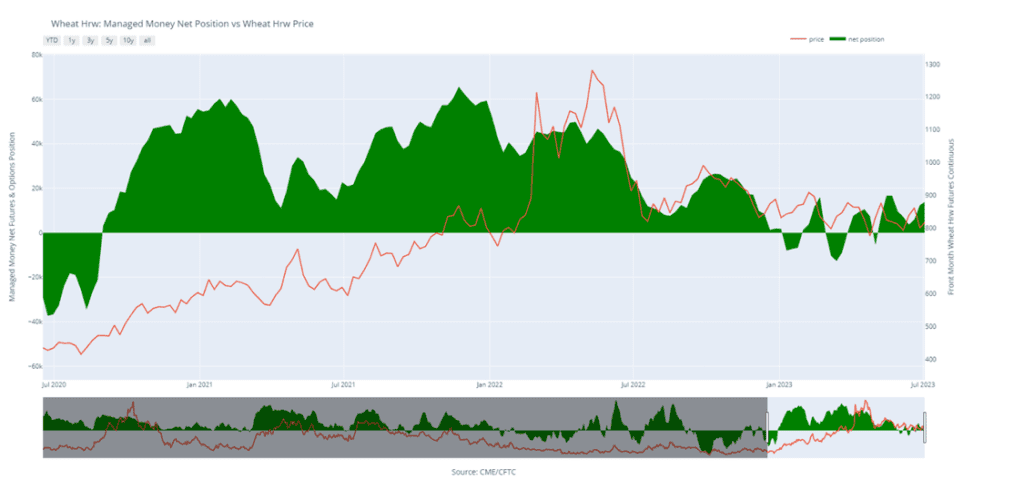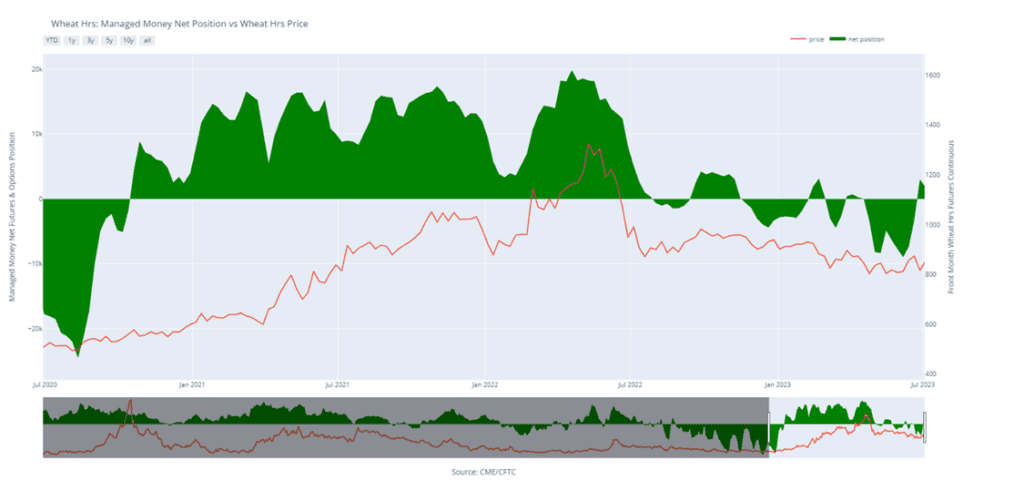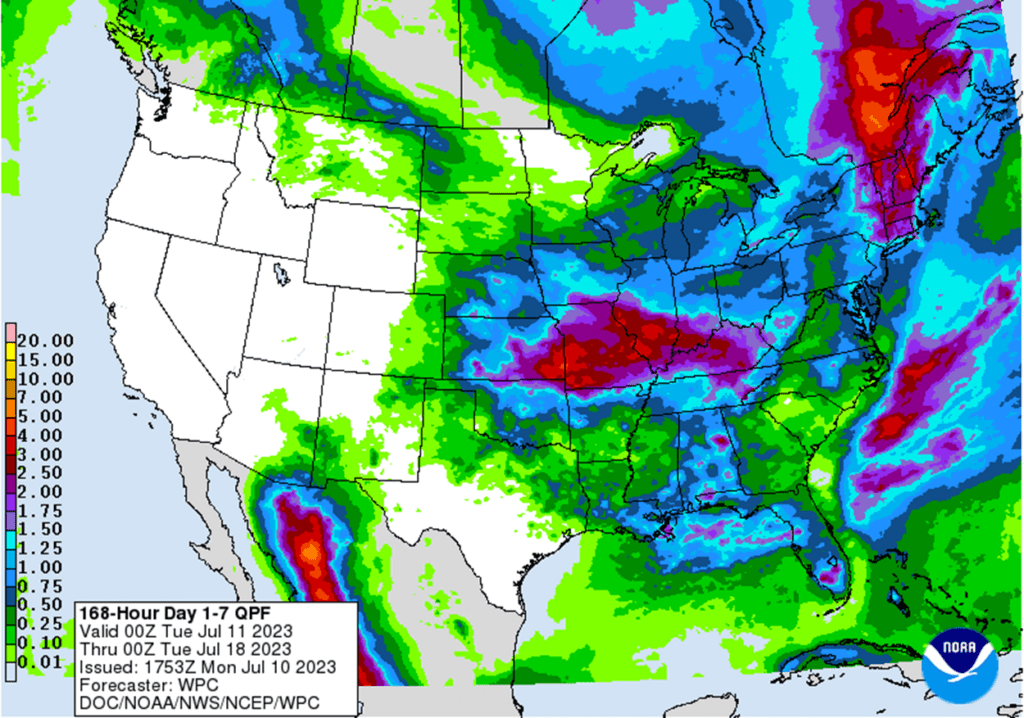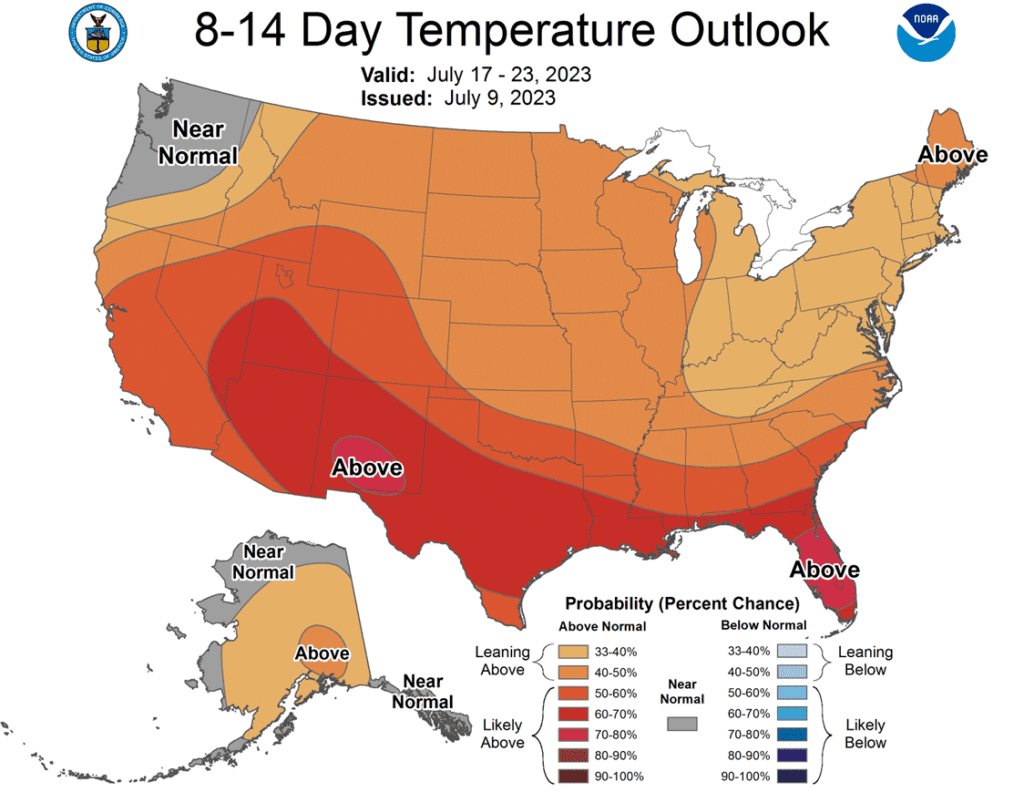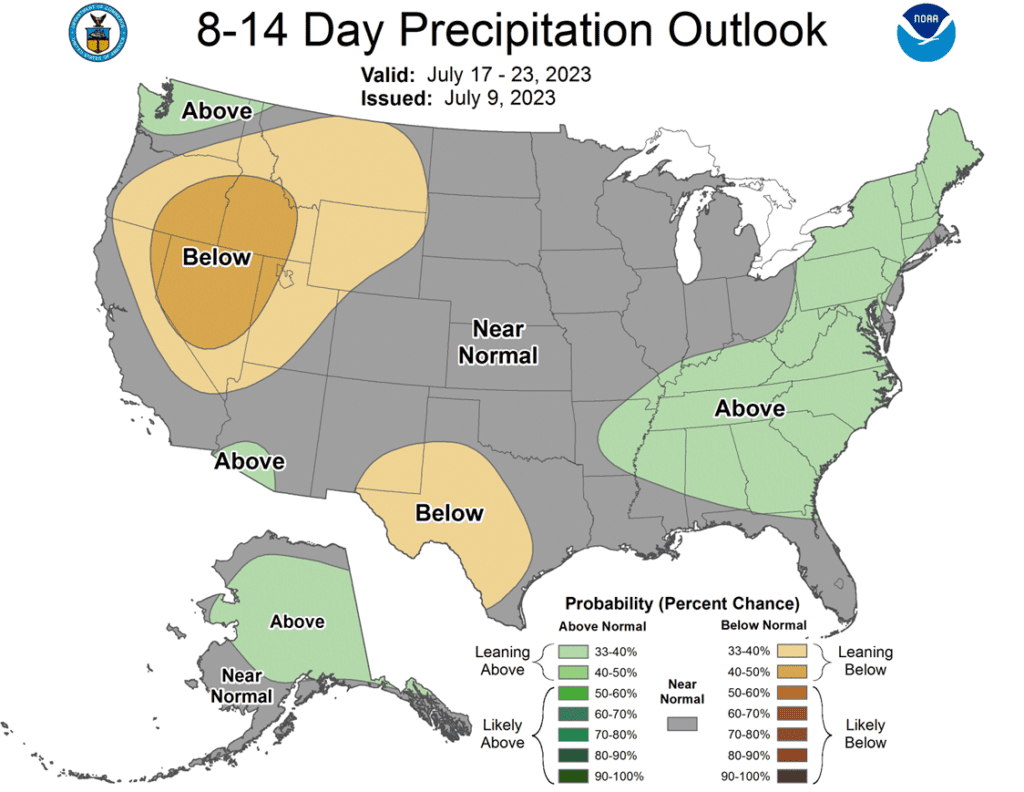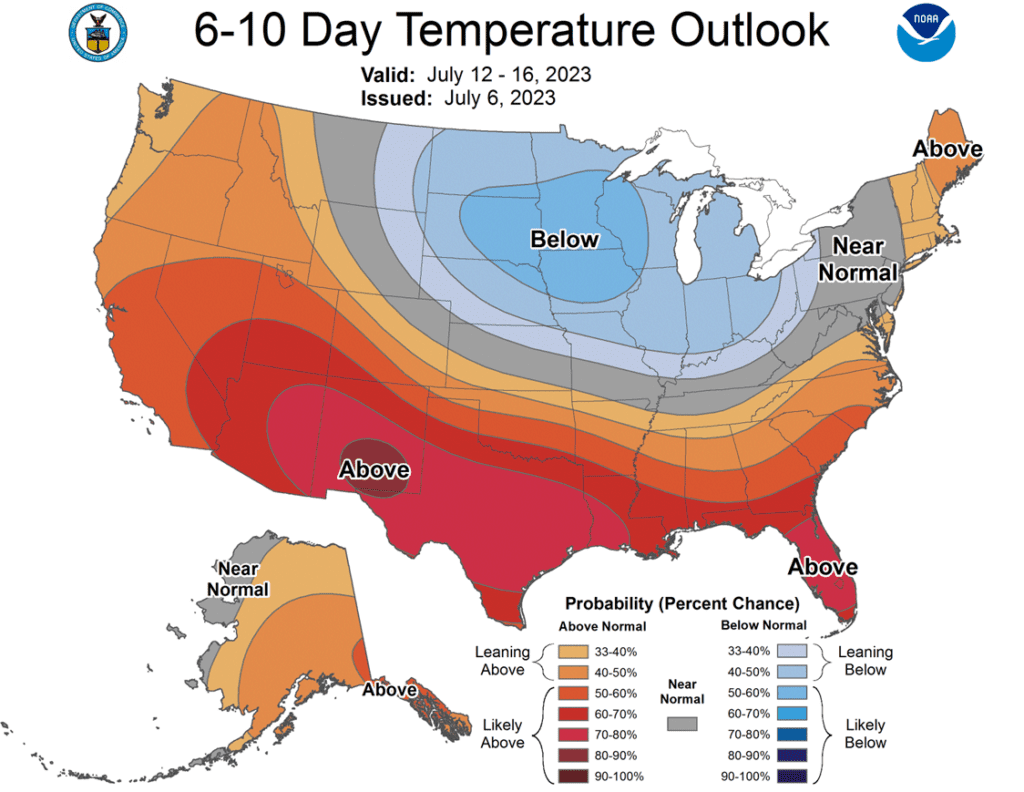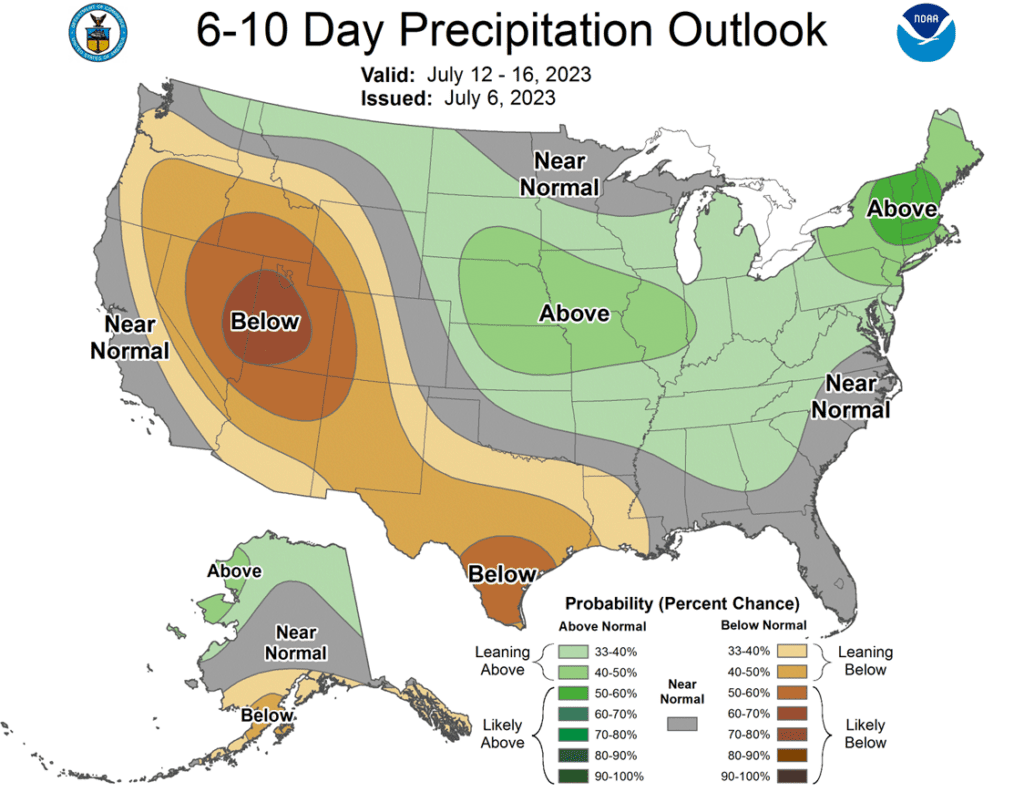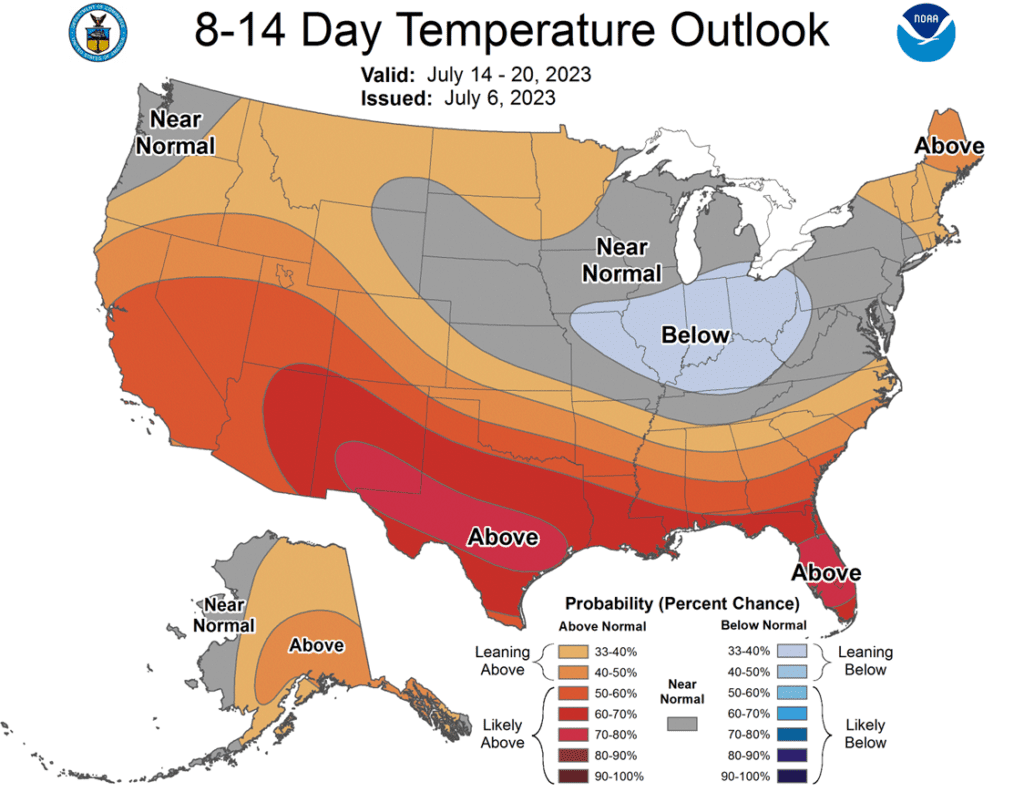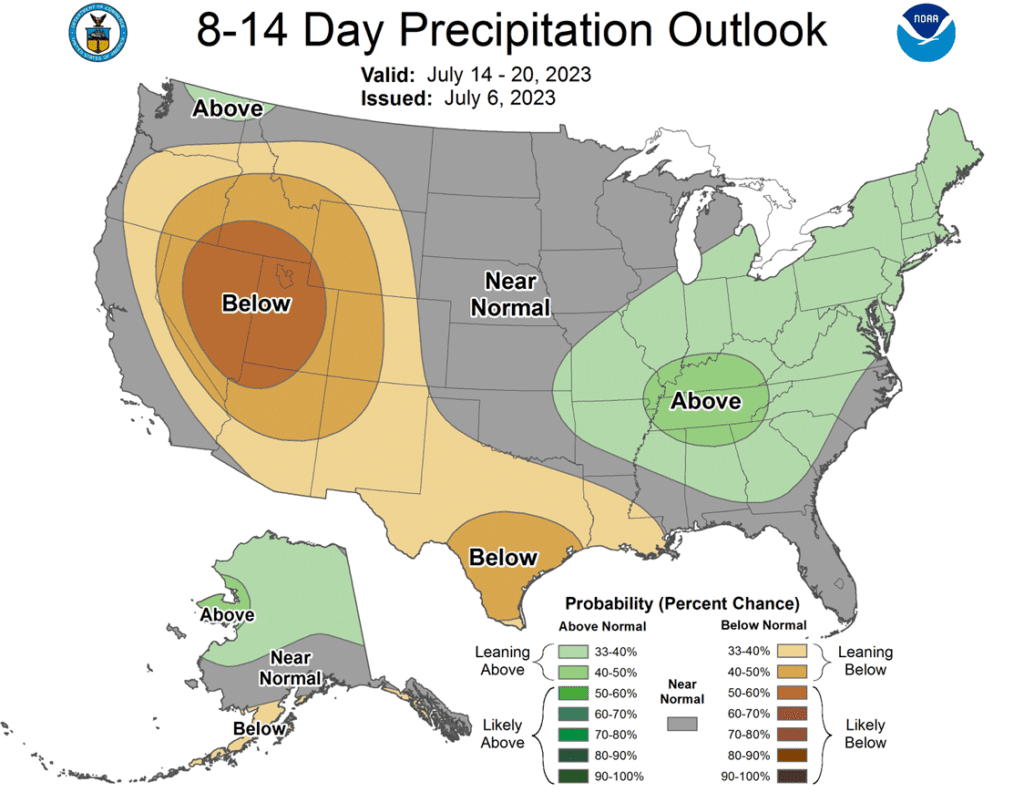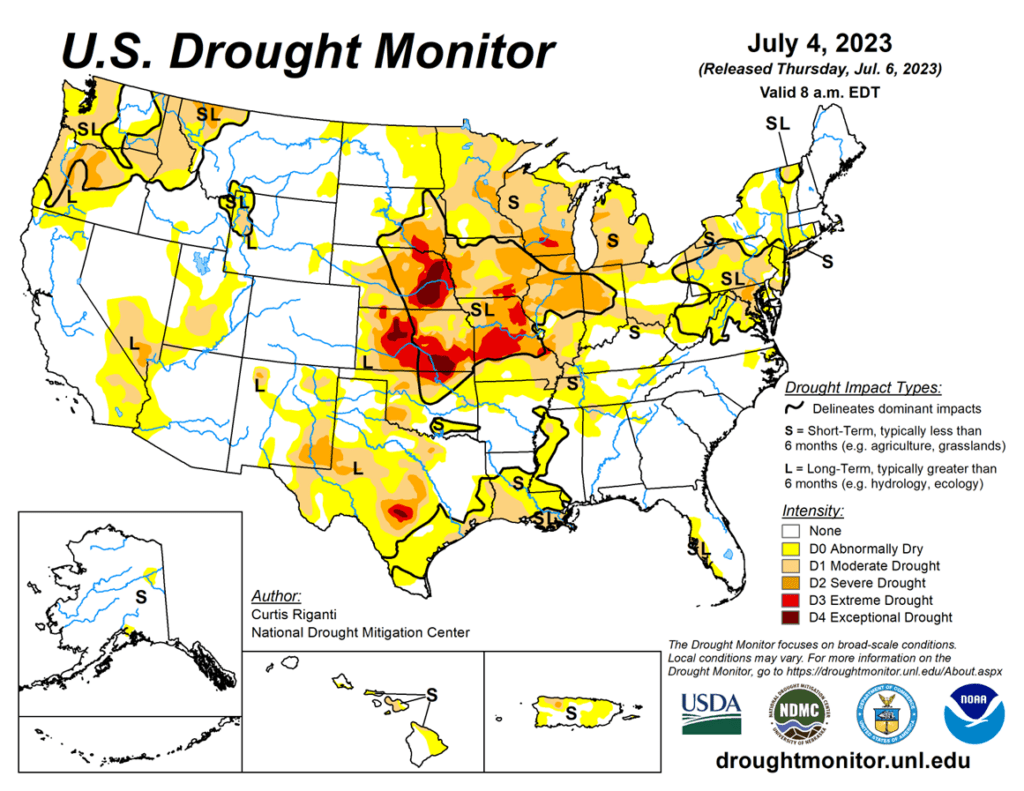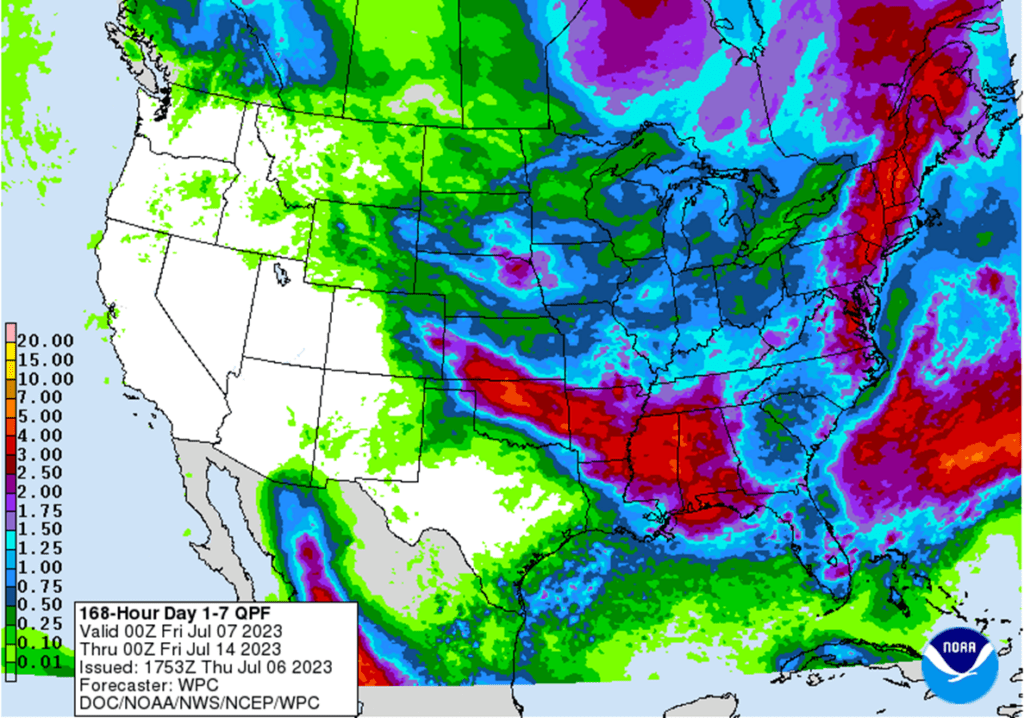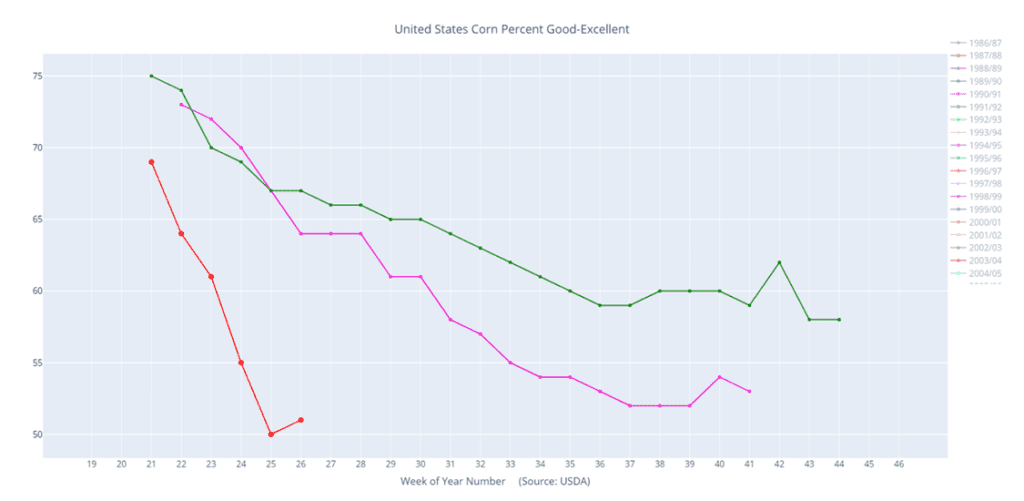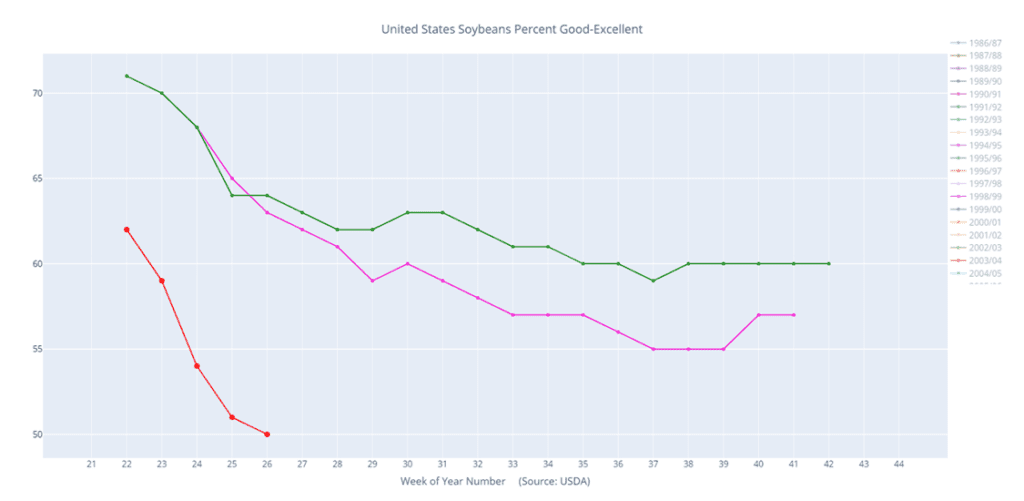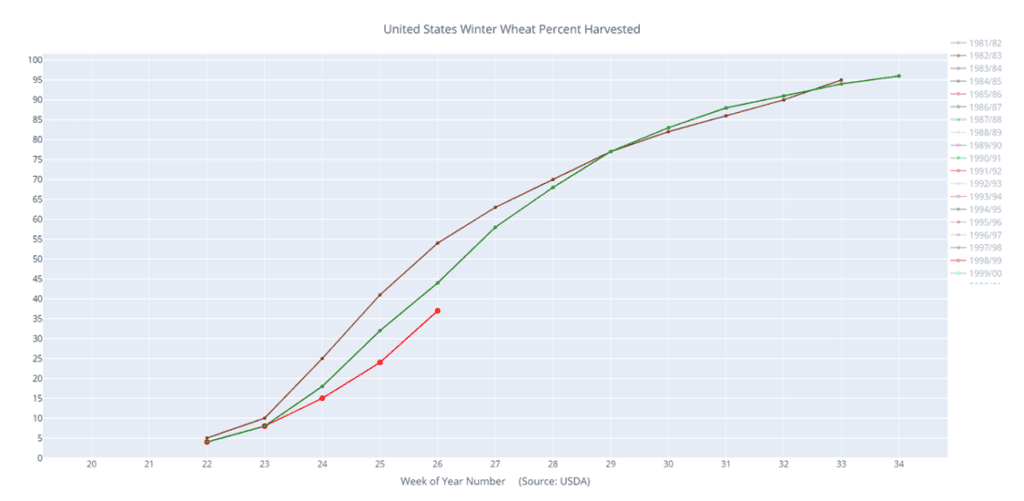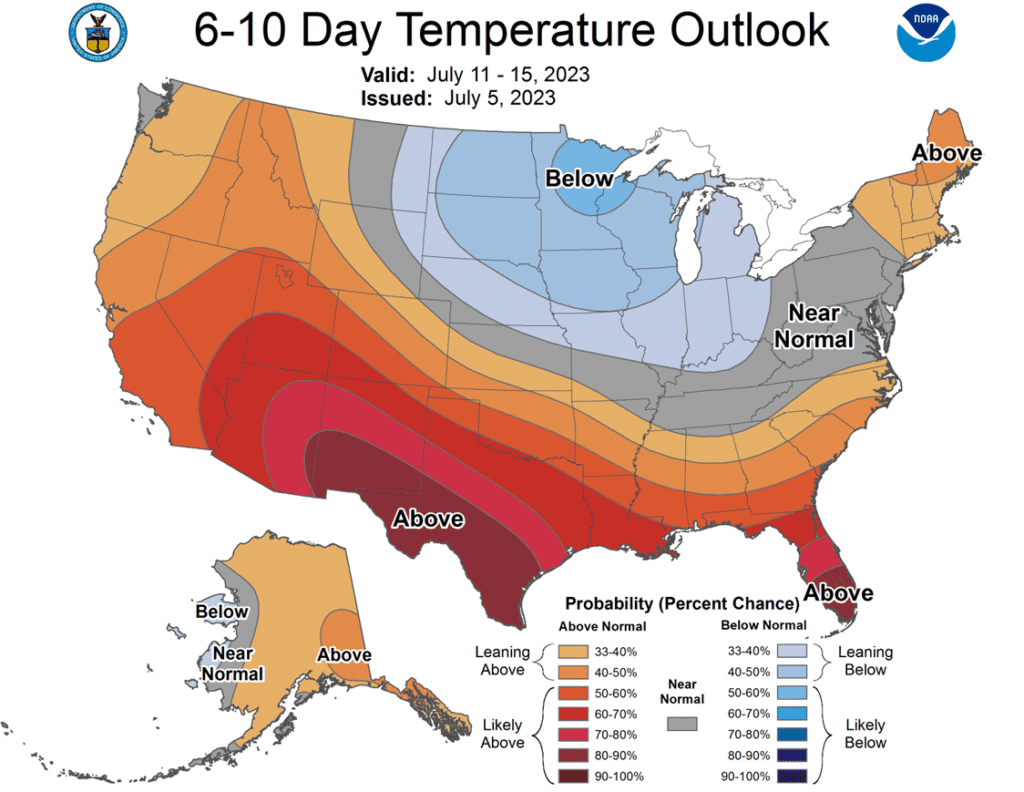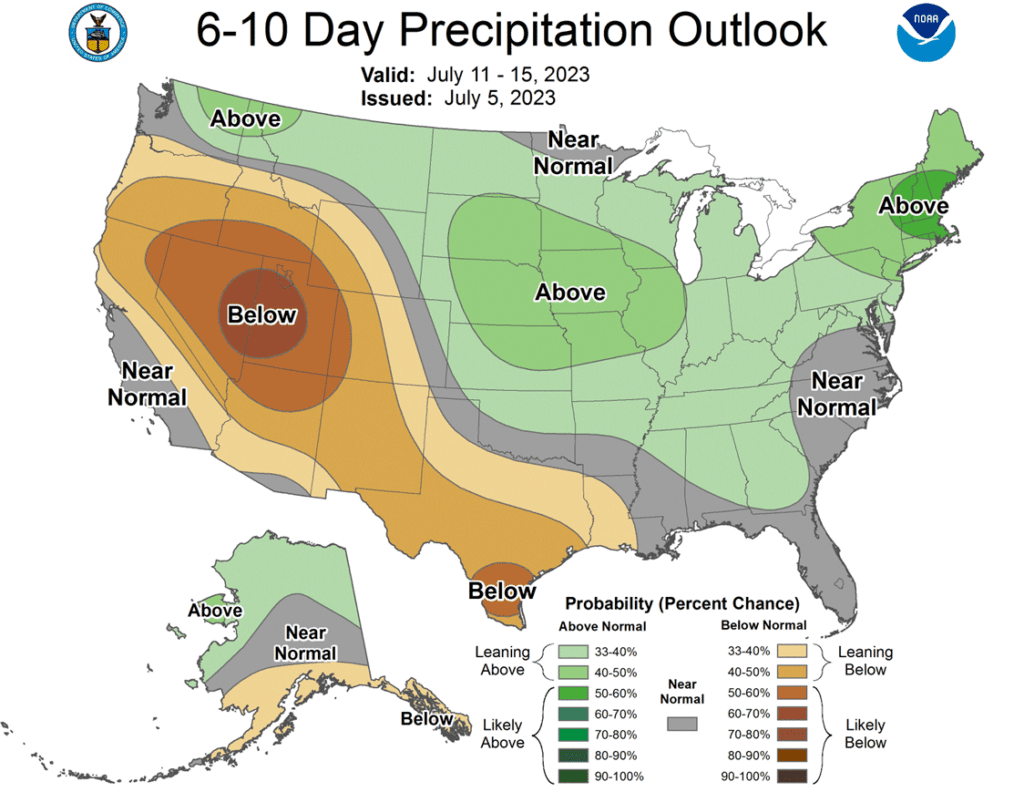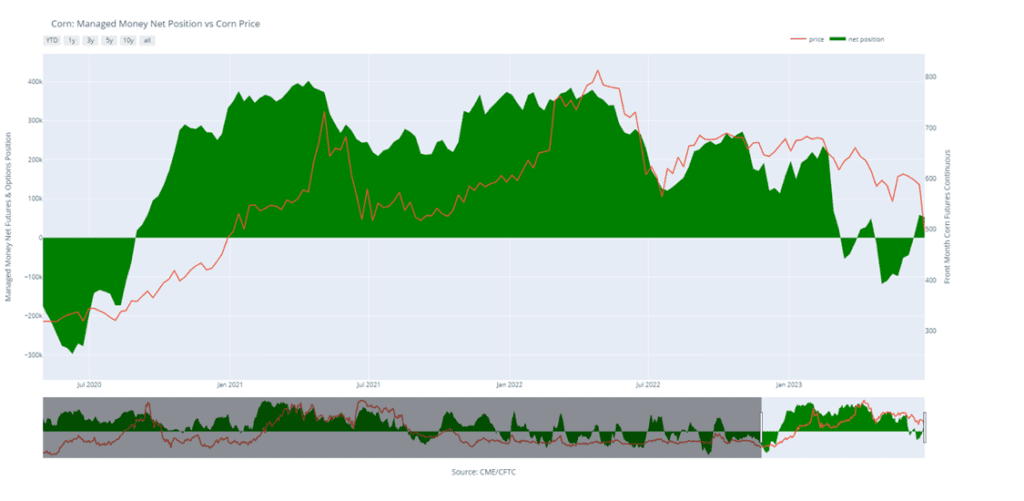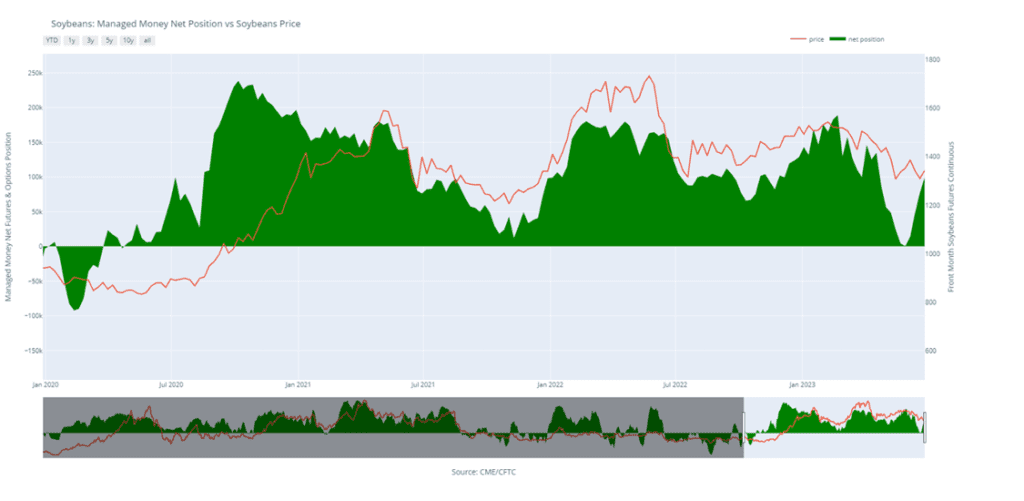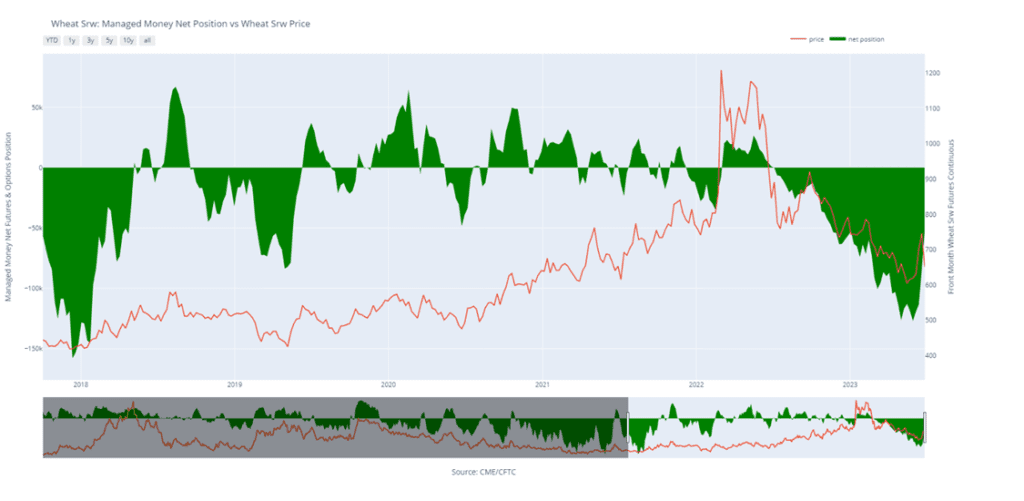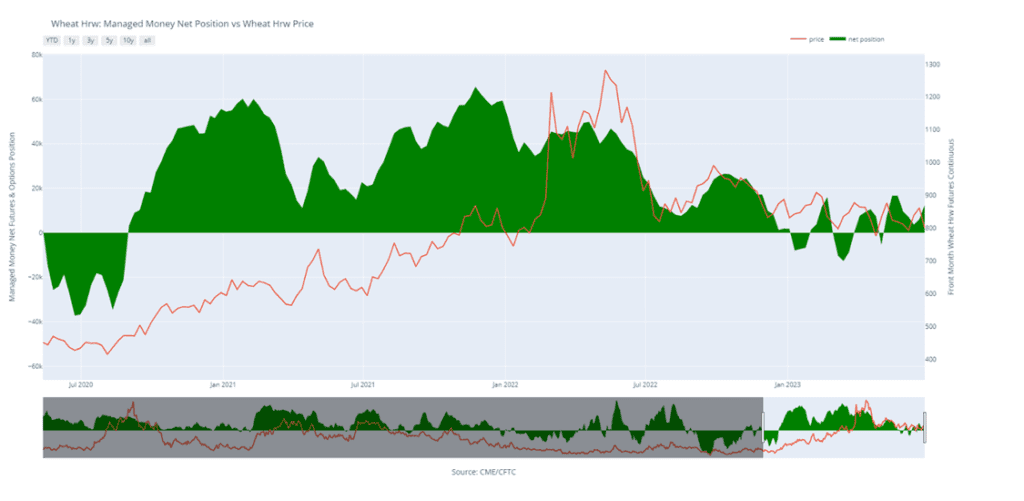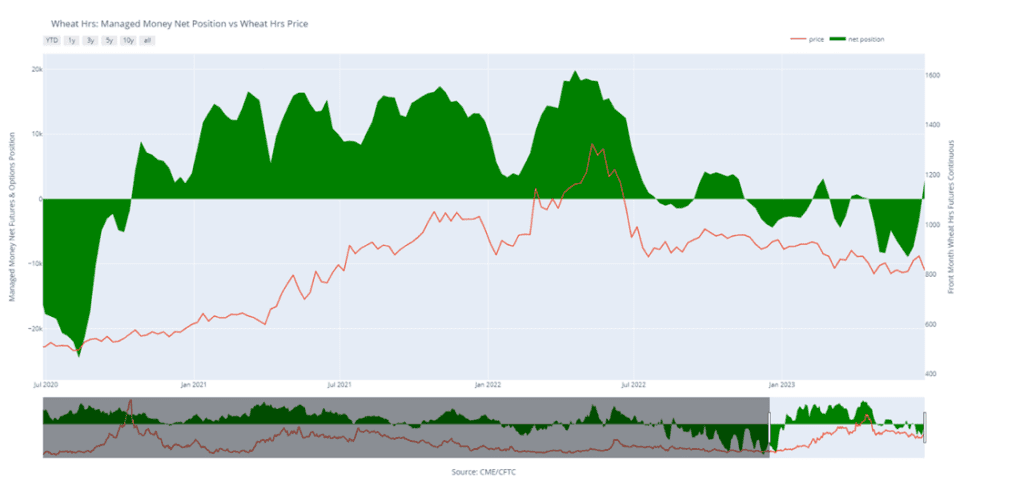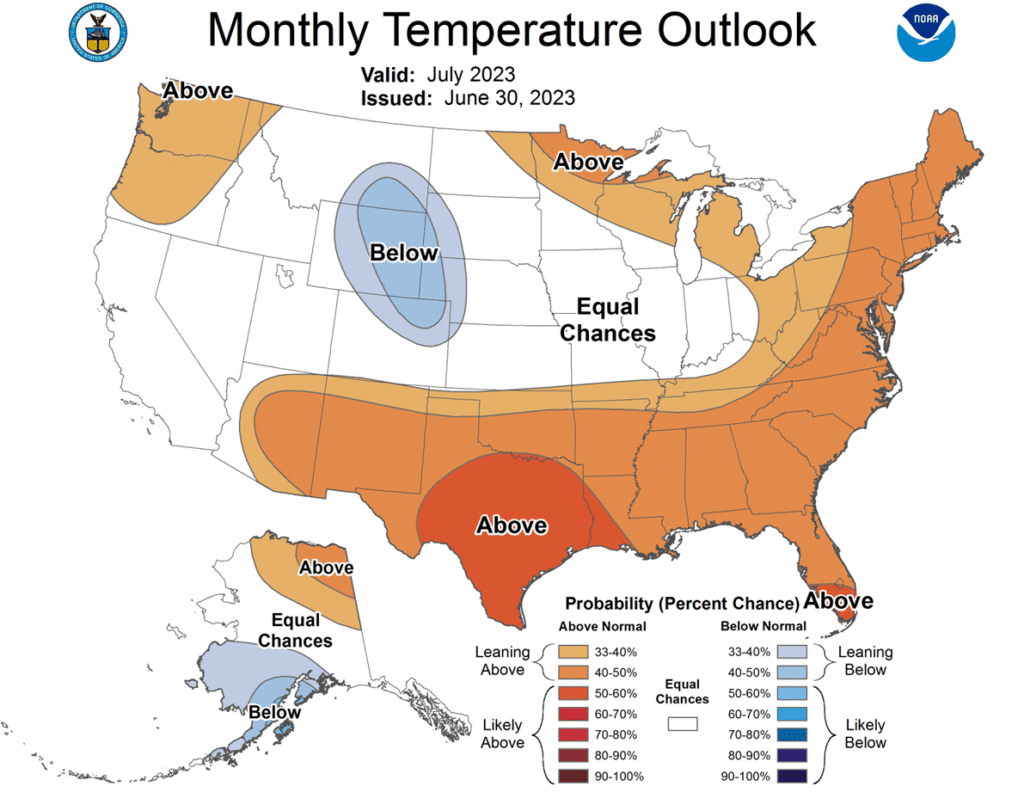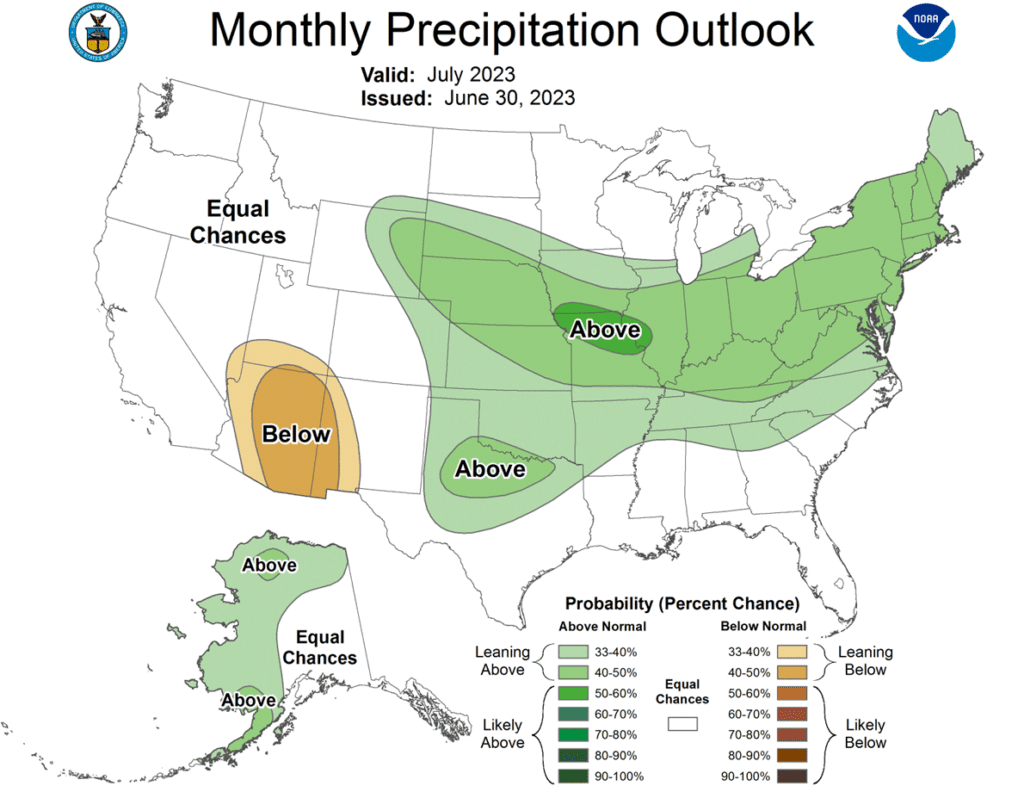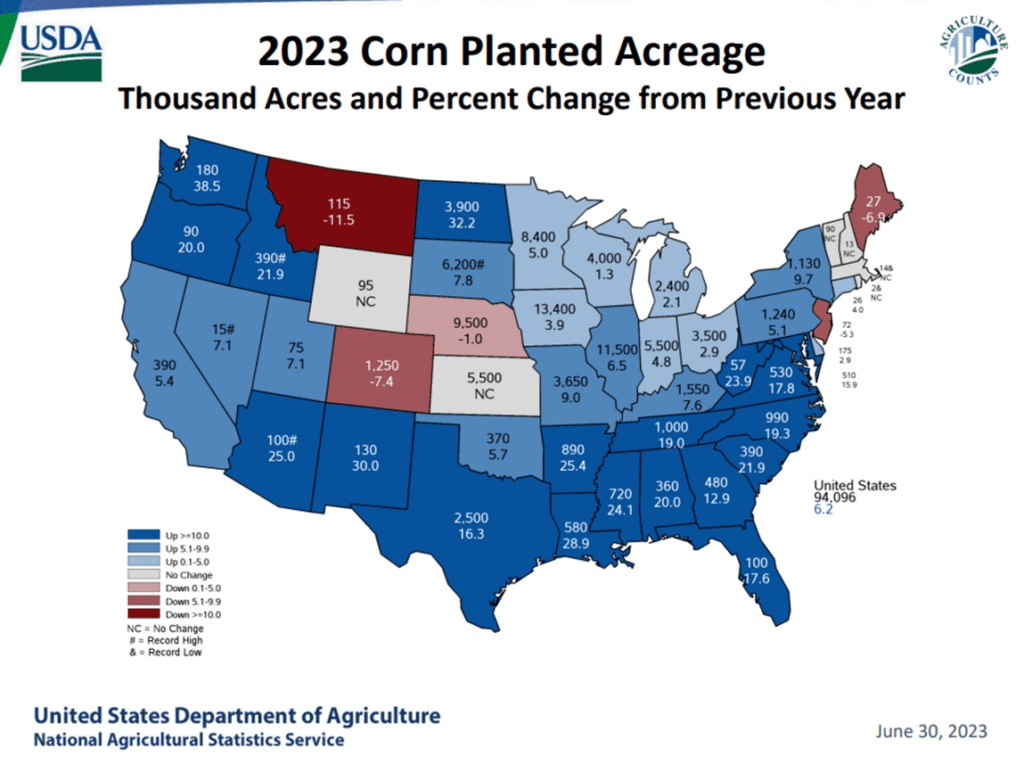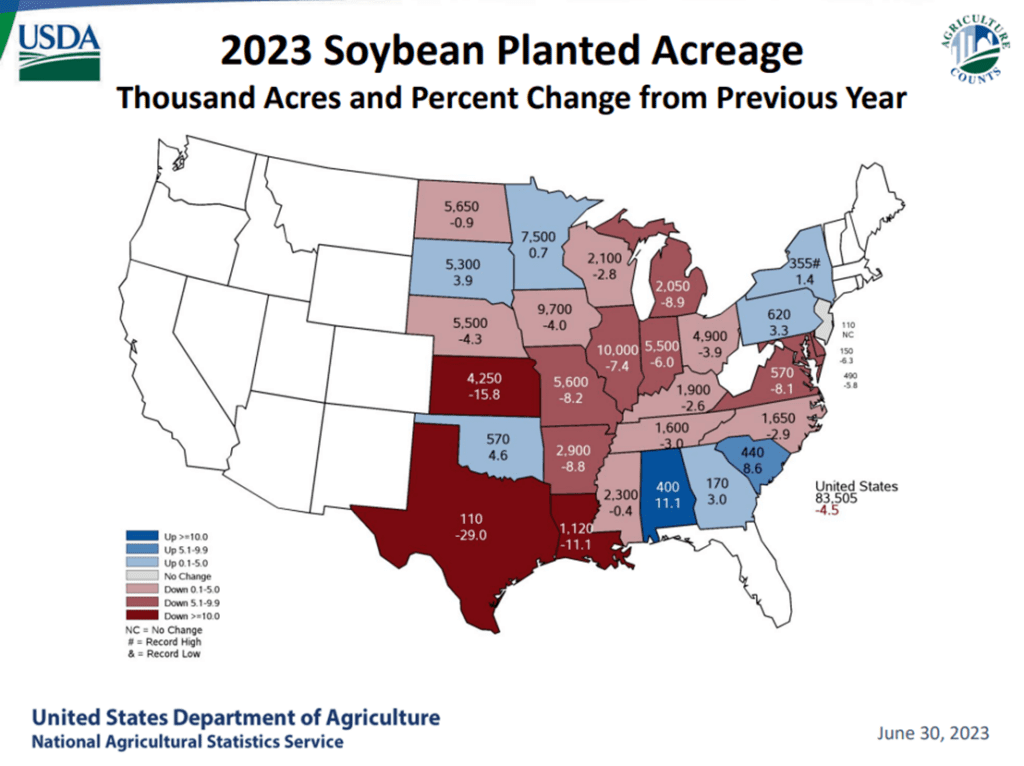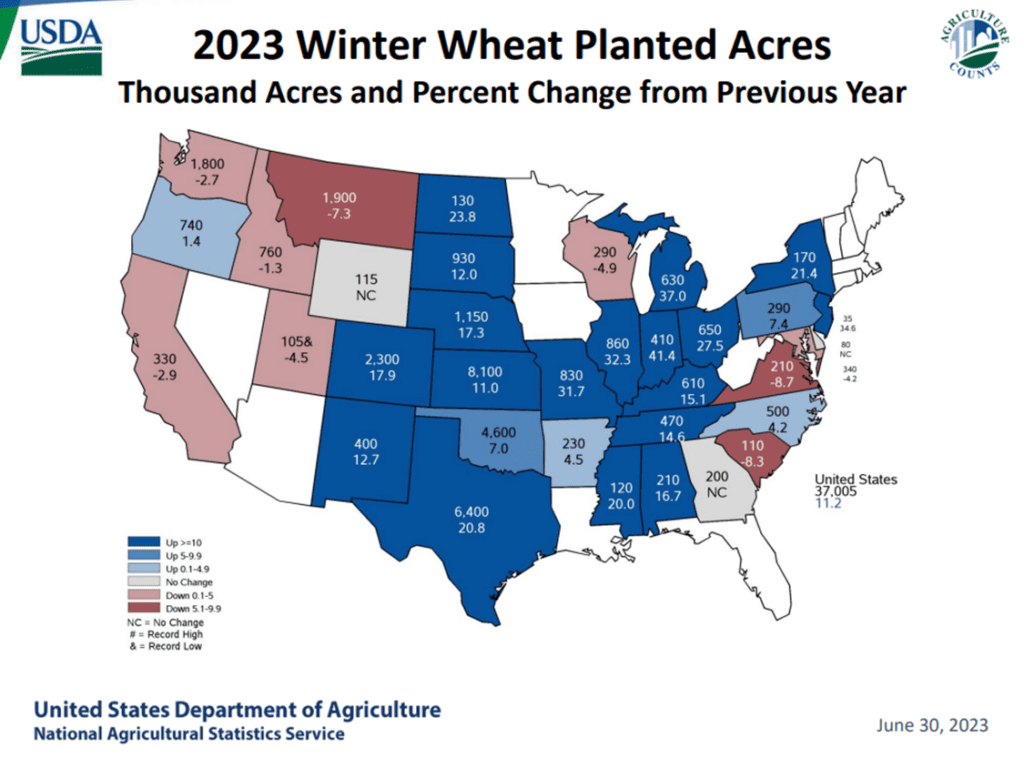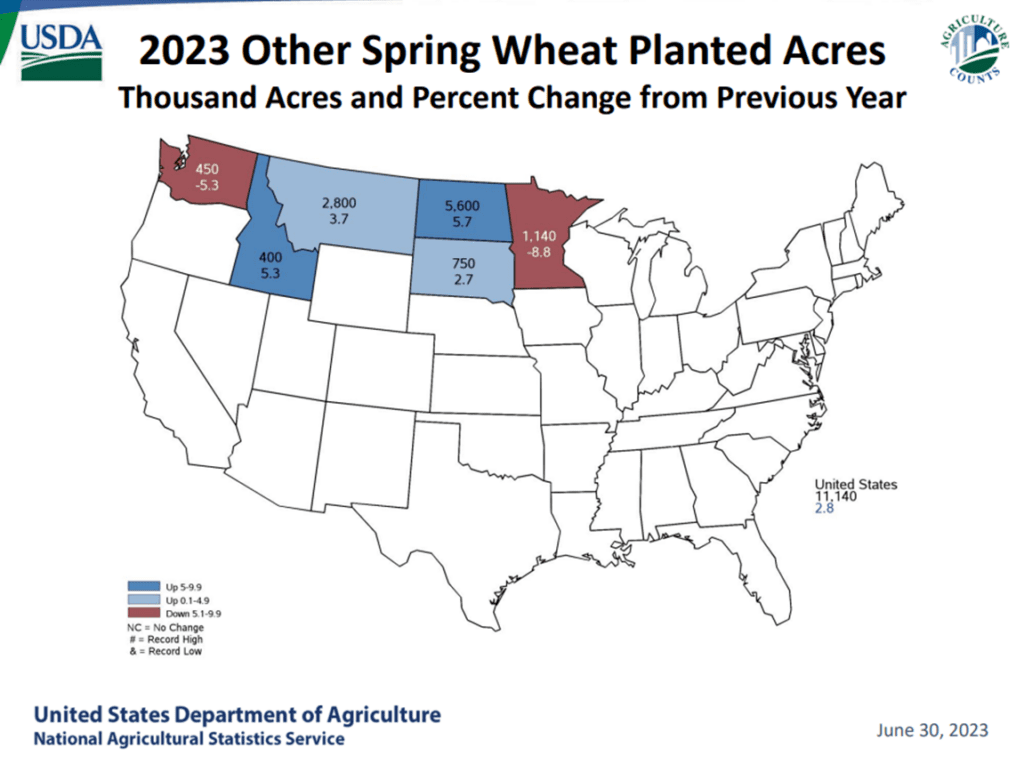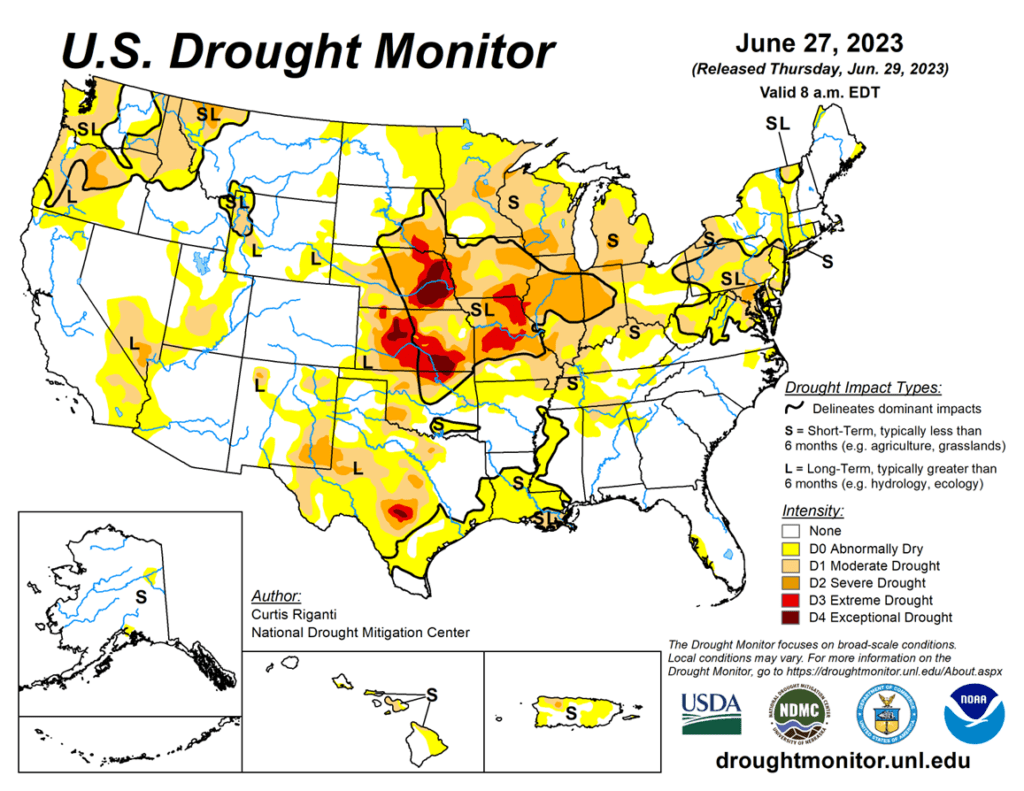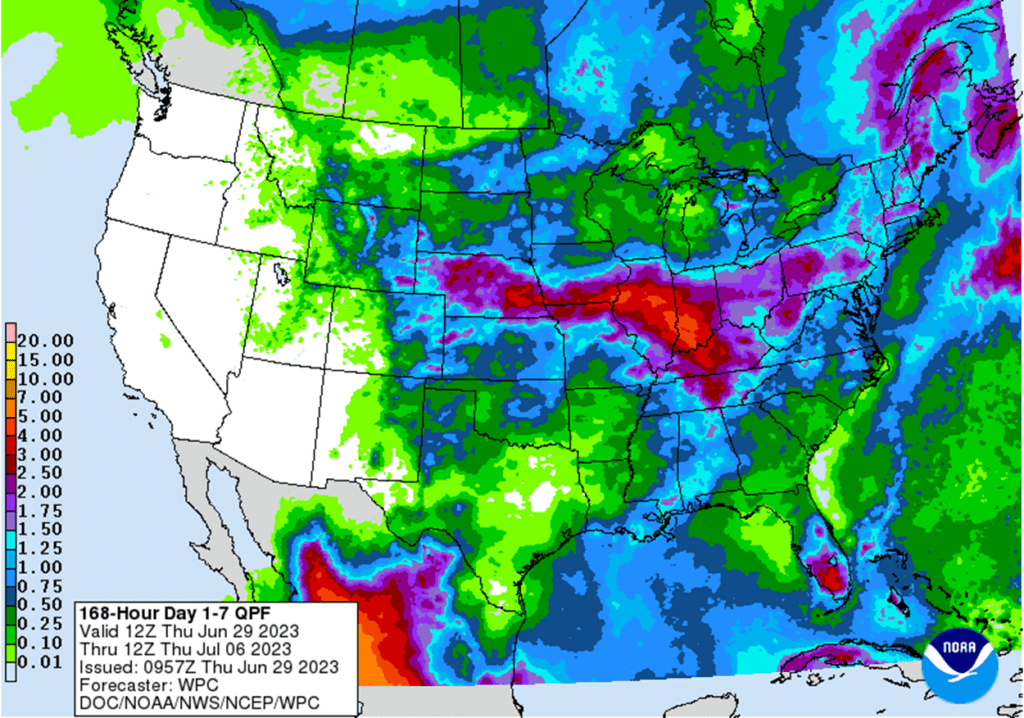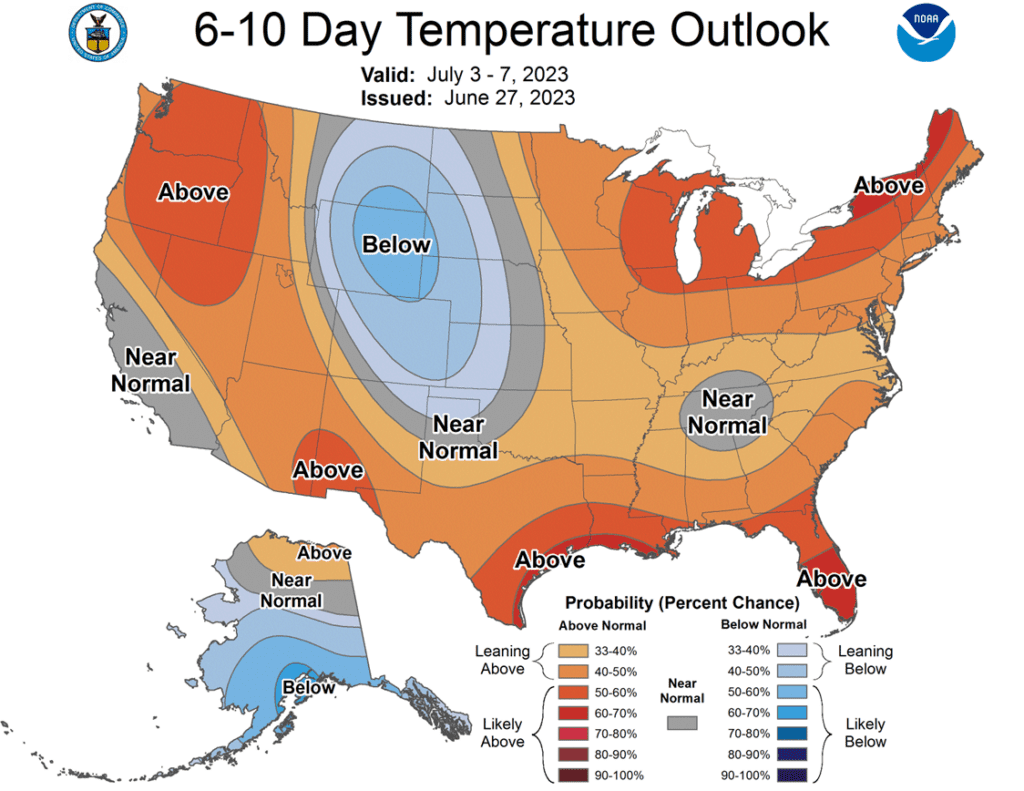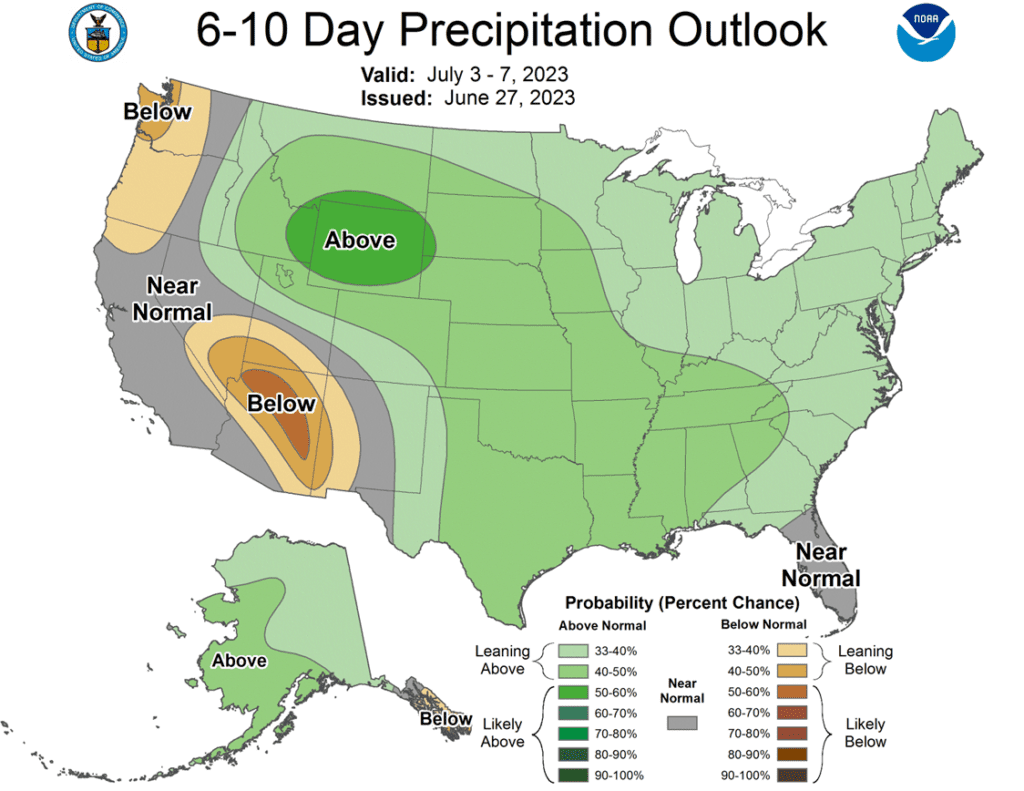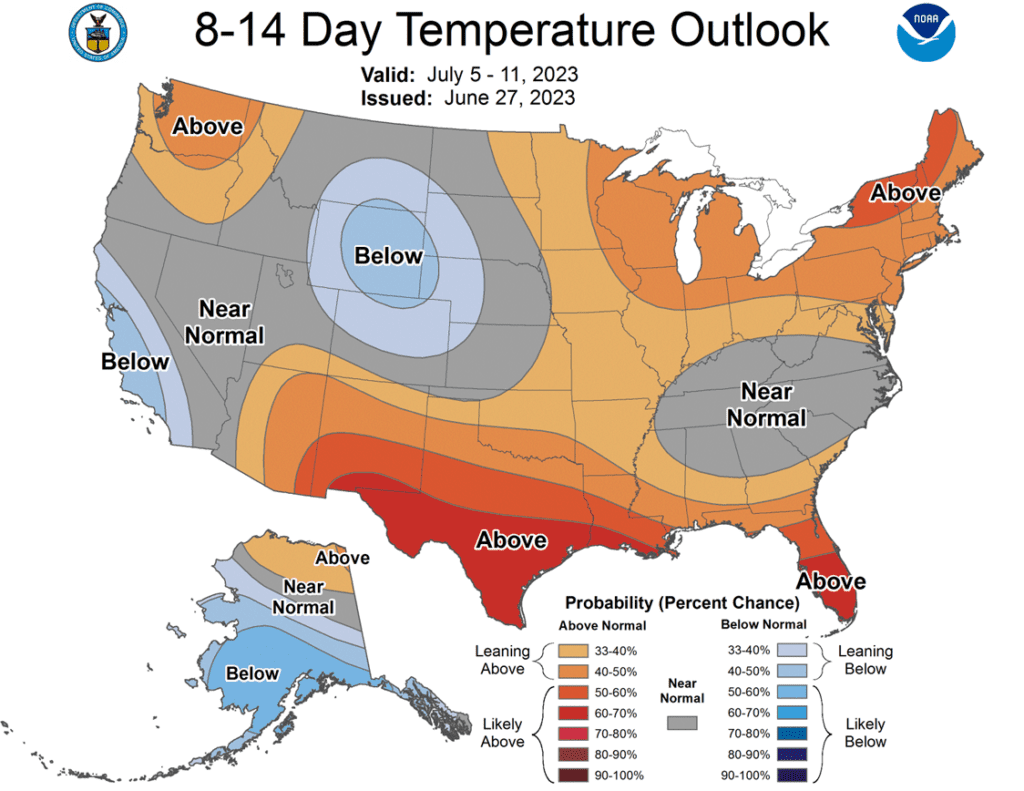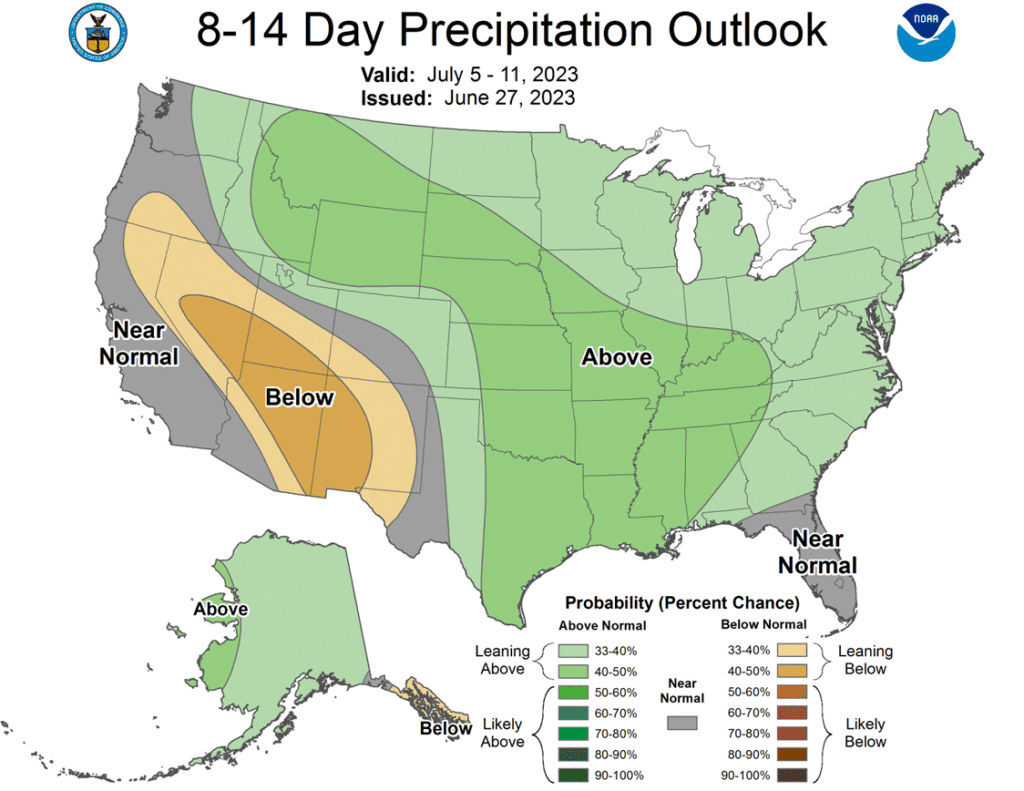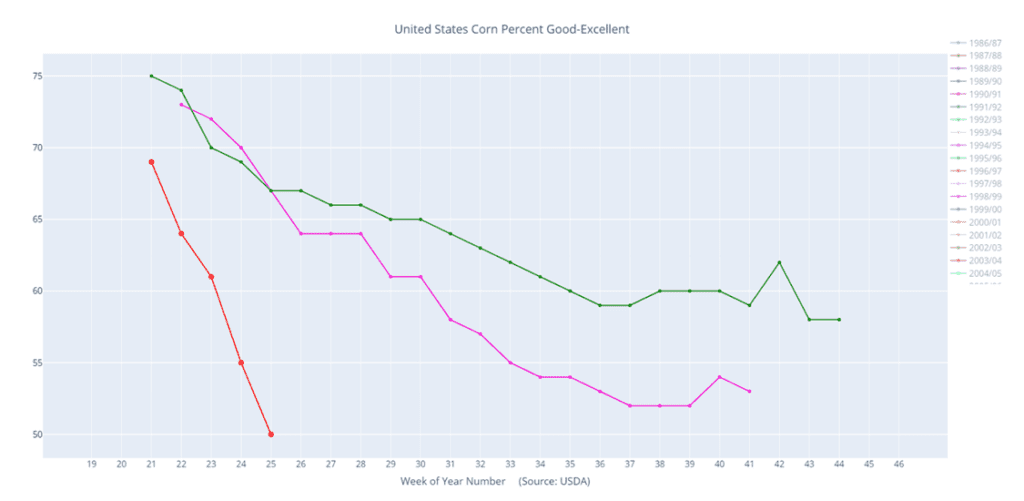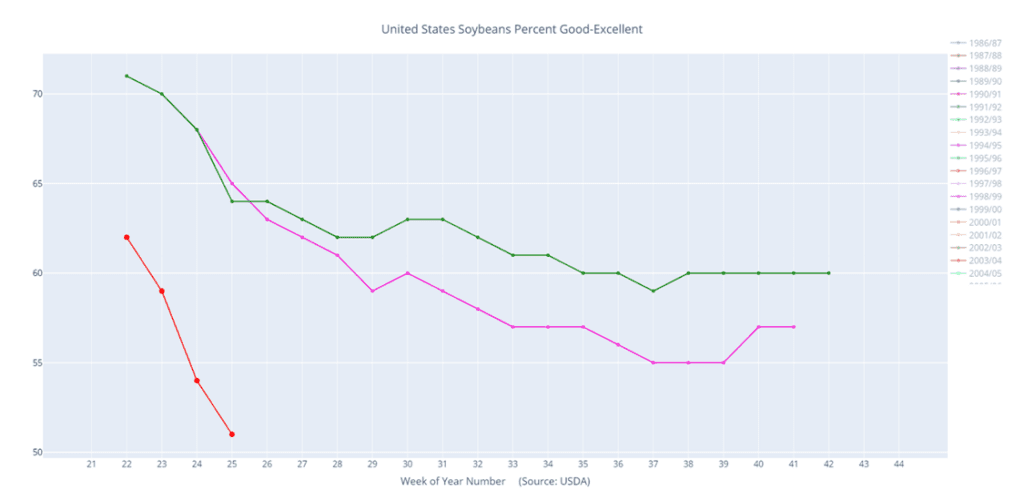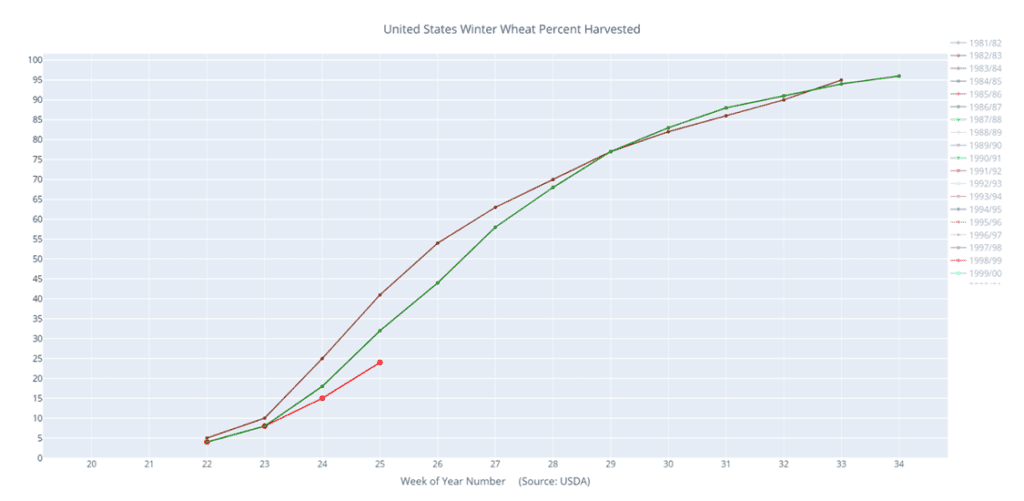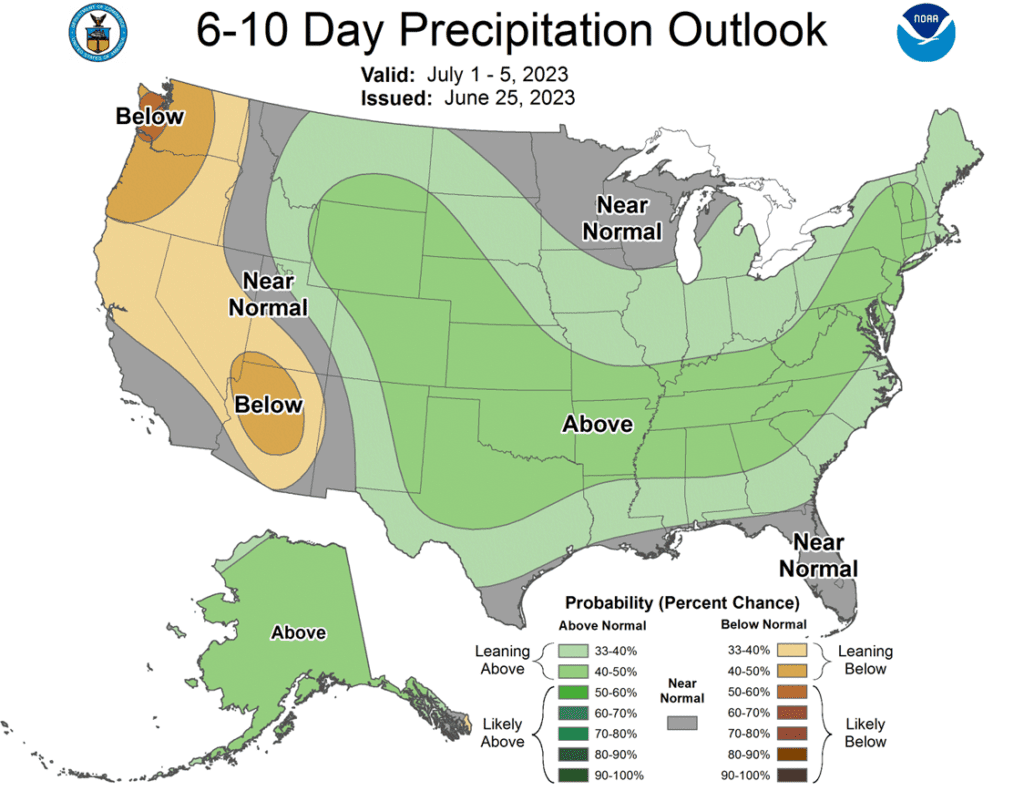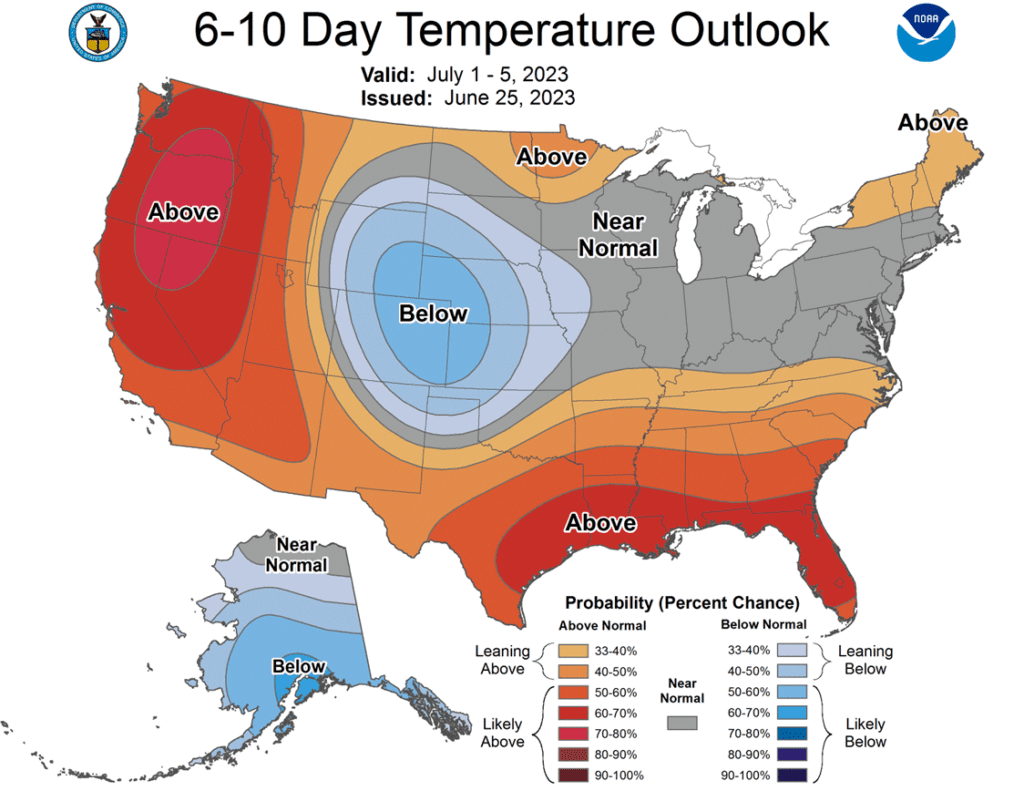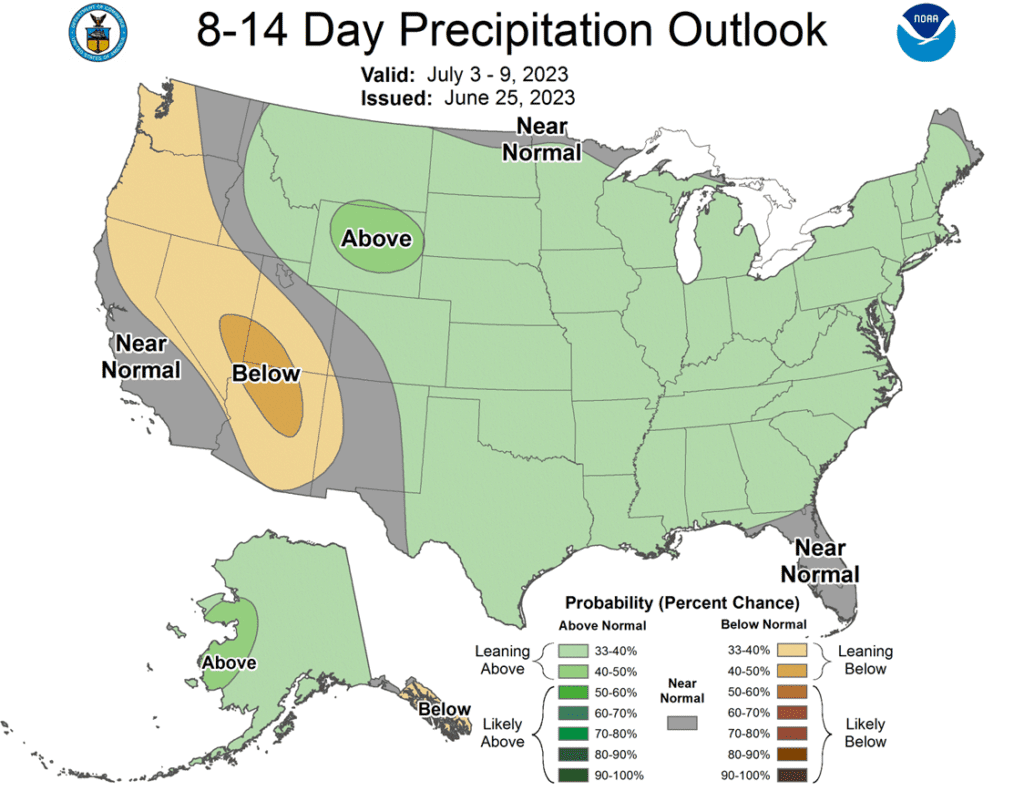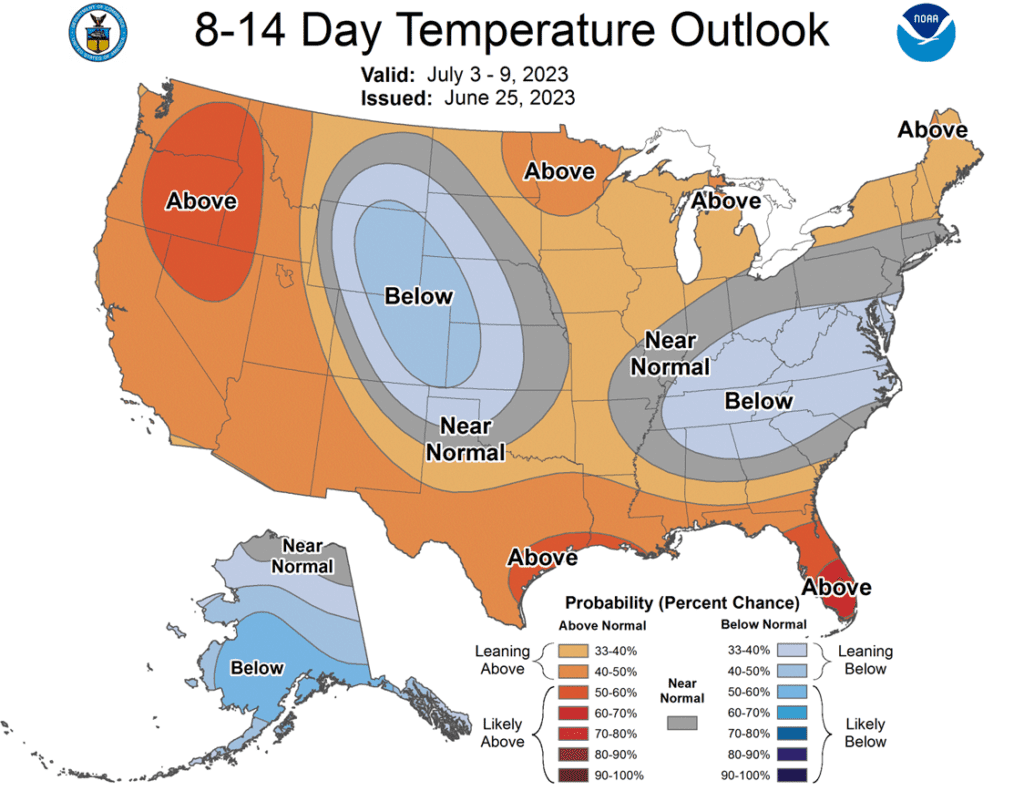Grain Market Insider: July 11, 2023
All prices as of 1:45 pm Central Time
Grain Market Highlights
- The corn market continues to hover and consolidate around the $5.00 December level as traders prepare for tomorrow’s July USDA report.
- Lower than expected crop conditions and anticipation of a 200 mbu haircut to 2023 soybean production in tomorrow’s USDA report kept traders on the buy side of the soybean market today.
- Soybean meal added support to soybeans as it followed through on yesterday’s strength to settle higher on the day, while soybean oil likely saw some profit taking from being overbought and settled lower in sympathy with lower palm oil.
- A slow winter wheat harvest and deteriorating spring wheat conditions added to the bullishness in the wheat market as all three wheat classes closed higher on the day.
- The grain markets may have gotten an extra boost of support as the US Dollar traded lower for the third day in a row, breaking through support and settling near 2-month lows.
- To see the current NOAA US 6 – 10 day Temperature and Precipitation outlooks, scroll down to the Other Charts/Weather Section.
Note – For the best viewing experience, some Grain Market Insider content is best viewed with your phone held horizontally.
Corn
Corn Action Plan Summary
- No new action is recommended for Old Crop. The market had a nearly 140-cent swing from the May low to the June high and back on weather. Use any remaining bounces in the market to price what Old Crop bushels you may have, if any. We won’t have any “New Alerts” for 2022 Corn (Cash, Calls, or Puts) as we have moved focus onto 2023 and 2024 Crop Year Opportunities.
- No action is recommended for New Crop 2023 corn. December corn rallied 139 cents from its May 18 low to its high on June 21 on weather and production concerns. The market is currently off that high on poor export sales figures and a forecast that shows increased chances of rain in the next couple of weeks. When Dec corn was trading over 620, Grain Market Insider recommended making a cash sale and buying Dec 580 puts to cover more downside. The Dec 580 puts, paired with the previously recommended Dec 610 calls, yields a combination of options commonly known as a Strangle, which benefits from dramatic market moves either up or down. Considering it is still early in the season, with drought and crop production uncertainty it is too soon to know if the market high is in or not. Either way, the Strangle position is prepared. If conditions improve from here and prices make new lows, unsold bushels will be protected with the 580 puts. If it doesn’t rain again and prices skyrocket to new highs, already sold bushels will be protected by the 610 calls.
- Grain Market Inside recommends selling New Crop 2024 Corn. While the market has seen some extreme volatility in recent weeks, we are entering a time of year when prices tend to have more headwinds than tailwinds to the upside. Also, with last week’s surprise acreage jump, continued rain in the forecast and slow demand, the size of the 2023 crop still has the potential to yield a carryout north of 2 billion bushels. A large 2023 carryout in the US, combined with the large corn crop in Brazil, could pose greater headwinds for 2024 prices. With it being the time of year to start getting early sales for next year on the books, and no recent bullish catalyst from the Stocks or Acreage reports, we are suggesting making a sale for the 2024 corn crop using either a DEC ’24 HTA contract or DEC ’24 futures, so the basis can be set at a later more advantageous date. While $5.00 futures is not the $6.00 or $7.00, we’ve become accustomed to the last few years, it’s still historically a good price to be getting some early sales on the books at.

- Corn prices consolidated again around the $5.00 price level as futures were firmer on Tuesday. December corn traded around the $5.00 area for the seventh consecutive session as traders square positions before Wednesday’s USDA report.
- The USDA will release the July Supply/Demand report on Wednesday at 11:00 CST. Expectations are for corn yield to drop to 176.6 bushels/acre, down 4.9 bushels/acres from the June report. Despite the yield drop, the additional acres and possible demand adjustment will likely keep new crop corn carryover near 2.250 billion bushels on the report.
- Improved weather across the Corn Belt was reflected in the weekly USDA crop rating released on Monday afternoon. The USDA crop ratings on Monday afternoon gained 4% to 55% good/excellent, slightly above analyst expectations. Nebraska saw the largest improvement, gaining 12% week over week. Illinois gained 6% in the good/excellent category but is still well behind the 5-year average at 39% good/excellent.
- The weather forecast will limit any near-term rally and rainfall chances and above-normal temperature should help additional crop recovery in some areas and stabilize the crop into pollination.

Above: The USDA added a bearish 4 million acres to its planted acreage estimate on June 30. The September contract is now extremely oversold and consolidating in the 480 – 505 support level that has been in place since January 2021. The oversold condition of the market would be considered supportive to higher prices if reversal action occurs; if not, there may not be much support until 390 – 415. Overhead lies strong resistance between 595 and 625.
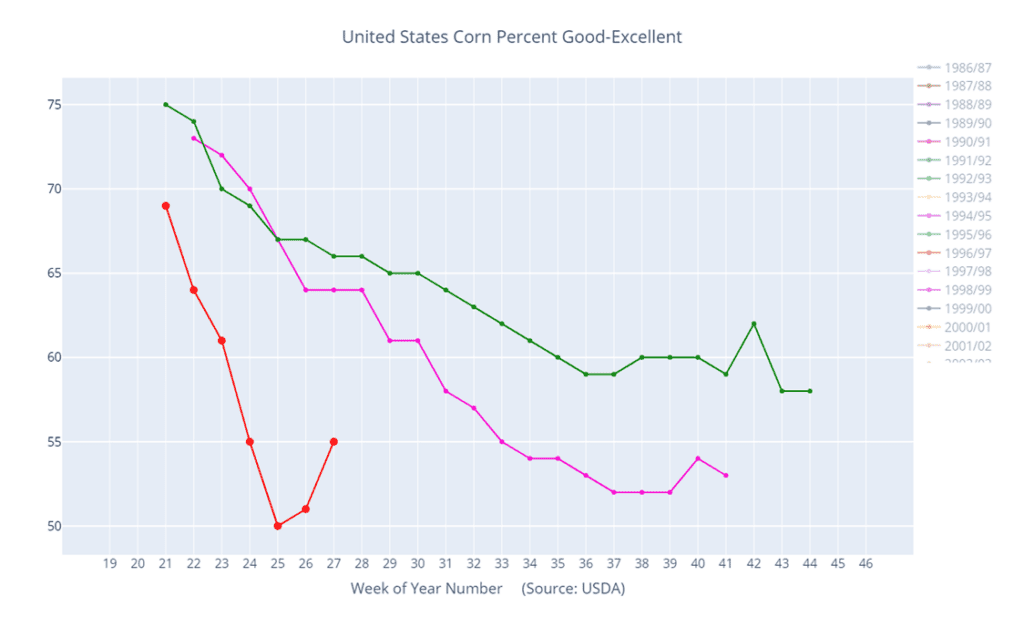
Above: 2023/24 Corn condition percent good-excellent (red) versus the 5-year average (green) and last year (pink).
Soybeans
Soybeans Action Plan Summary
- No new action is being recommended for Old Crop. Any remaining old crop bushels should be getting priced into this rally. We won’t have any “New Alerts” for 2022 Soybeans (Cash, Calls, or Puts) as we have moved focus onto 2023 and 2024 Crop Year Opportunities.
- No action is being recommended for New Crop 2023 soybeans. No action is being recommended for New Crop 2023 soybeans. While changing weather forecasts will continue to dominate price action, a potentially much lower than anticipated 2023 carryout looms over the market due to low crop condition ratings and a reduced planted acreage estimate. Grain Market Insider is still eyeing a rally to the 1400 – 1450 area before considering any additional 2023 cash sales. Yet given the time of year and how fast prices can change direction, we’re willing to change that plan at a moment’s notice. In view of the current crop conditions and carryout situation and that we recently recommended making a cash sale, we suggest holding tight on further cash sales for now.
- No action is recommended for 2024 crop. Grain Market Insider continues to monitor any developments for the 2024 crop, though it may not be until after harvest or toward year’s end before we will consider recommending any 2024 crop sales.
- The USDA rated the US soybean crop as of Sunday, July 9, at 51% good to excellent, a 1% increase from last week, but also 1% below trade expectations and 11% below year-ago levels. Although soybean crop conditions improved, they remain at their lowest levels since 2012.
- The average trade guess for 2022 ending stocks on tomorrow’s USDA WASDE report is 232 mbu, up 2 mbu versus the June estimate of 230 mbu, largely due to reduced demand. For 2023, due to much reduced acres, the average estimate for ending stocks is 203 mbu with a 51.3 bpa, versus a 350 mbu estimate last month.
- The trade estimates Brazil’s soybean production to come in at 156.2 mmt in Wednesday’s USDA report, up slightly from the June estimate of 156 mmt. For Argentina’s production, the average trade guess is 23.6 mmt, 1.4 mmt lower than in June.
- South American basis is improving which is allowing US soybeans to be more competitive in the world market, though they remain above SA offers.
- It has been rumored that China bought 10-14 cargoes of US soybeans off the PNW for October delivery for their reserves.
- Over the next 10 days, Minnesota, the Dakotas, Wisconsin, and northern Iowa are all expected to be mostly dry, with decent rain expected through eastern Nebraska, southern Iowa and Missouri, and into Illinois and the eastern Corn Belt.

Above: The USDA’s Stocks and Acreage estimate came in well below expectations and gave the market a solid push to the upside. The market has now fallen back and is struggling to continue higher without additional bullish input. If the market can rebound, resistance above the market continues to rest between 1500 – 1550, while support below the market could be found between 1340 and 1300 with further support near 1270.
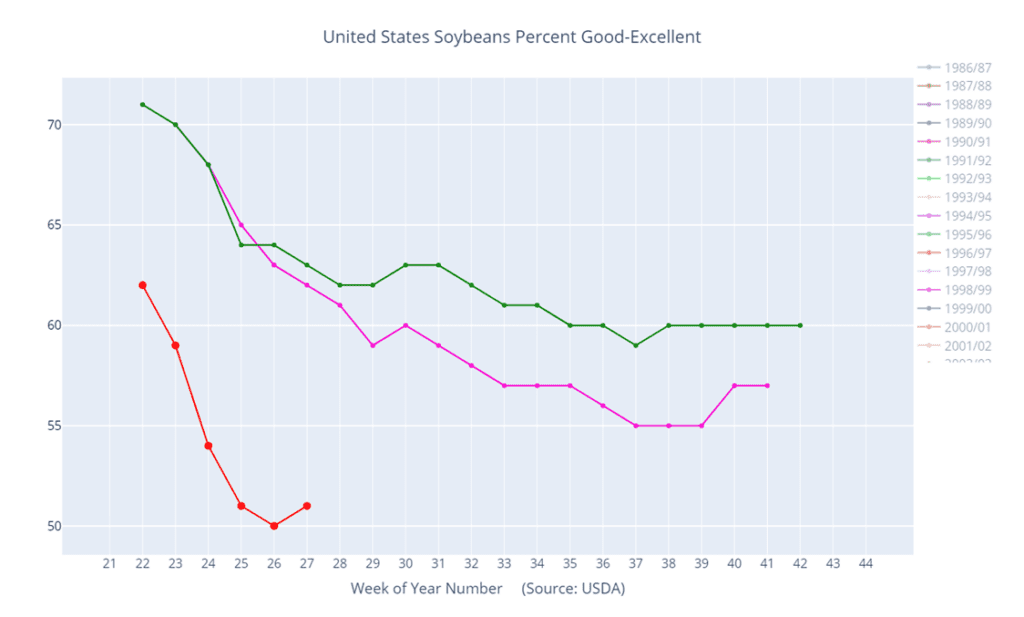
Above: 2023/24 Soybeans condition percent good-excellent (red) versus the 5-year average (green) and last year (pink).
Wheat
Market Notes: Wheat
- Yesterday afternoon’s USDA Crop Progress report kept winter wheat condition unchanged at 40% good to excellent, with harvest still well behind at 46% complete versus the average of 59%.
- Spring wheat conditions declined 1% to 47% good to excellent. The northern Plains could use some more rain to help this crop, but little is in this week’s forecast. Canda’s crop is also in a similar situation where more moisture is needed.
- According to CONAB, as of July 1st, Brazil’s wheat crop is 79.6% planted, with Argentina’s reported to be 81.4% planted.
- Japan is tendering for 60,000 mt of feed wheat. While it is possible this may stir up some US export business, Russia continues to offer cheap wheat FOB exports at $235-$240 per ton. However, interior Russian wheat prices are said to have recently rallied.
- Paris milling wheat futures posted gains for the first time in three sessions, which offered some support to the US market today. Additionally, the US Dollar continues to fade off of recent highs, allowing more upside potential for wheat futures.
- Daily stochastic indicators show that Chicago wheat is technically oversold and is close to a crossover signal. Barring any surprises in tomorrow’s USDA report, this would indicate that it could be due for more of a correction to the upside.
Chicago Wheat Action Plan Summary
- No new action is recommended for 2023 New Crop. In the month of June, the September Chicago wheat contract posted a 163-cent range and has largely been a follower of the corn market which has been mostly driven by weather. While demand remains weak, production concerns in parts of the country remain, as does uncertainty surrounding the Black Sea region and the potential for major exporting countries’ inventory to hit 16-year lows. While Grain Market Insider will continue to monitor the downside for any violation of major support, following the recent sales recommendation it may be after harvest or near the end of summer before we consider recommending any additional sales for the 2023 crop.
- No action is currently recommended for 2024 Chicago wheat. Price volatility has risen in the last couple of weeks due to the changing weather forecasts and current events in the Black Sea. While prices have fallen off their recent highs, plenty of time remains to market next year’s crop. War continues in the Black Sea region, major exporting countries’ stocks expected to fall to 16-year lows, and no one knows what the weather will bring, leaving the market vulnerable to many uncertainties. For now, after recently recommending making a sale for the 2024 crop, and while keeping an eye on the market to see if any major support is broken, Grain Market Insider would need to see prices north of 800 before considering recommending any additional sales.
- No Action is currently recommended for 2025 Chicago Wheat. 2025 markets are very illiquid right now, and it may be some time before conditions are conducive to consider making any recommendations. Be patient as we monitor the markets for signs of improvement.

Above: September wheat rallied nearly 200 cents from the May low to its June high when it encountered heavy resistance and posted a bearish reversal. This technical formation on the price chart is considered bearish and momentum may be adding to the bearish tone. Support below the market may be found between 650 – 610, while resistance above the market rests between 770 – 810.
KC Wheat Action Plan Summary
- We continue to look for better prices before making any 2023 sales. While Crop ratings have improved and the Black Sea export corridor remains open, questions remain about the size of the HRW crop, whether Russia will continue to agree to keep the Black Sea corridor open, and what production looks like in Europe and Australia. We continue to target 950 – 1000 in the July futures as a potential level to suggest the next round of New Crop sales.
- Patience is warranted for the 2024 crop. With continued issues in the Black Sea region and with major exporting countries’ stocks expected to fall to 16-year lows, we are willing to be patient with further sales of New Crop HRW wheat. We are targeting just below the 900 level on the upside while keeping an eye on recent lows for any violation of support.
- No Action is currently recommended for 2025 Chicago Wheat. 2025 markets are very illiquid right now, and it may be some time before conditions are conducive to consider making any recommendations. Be patient as we monitor the markets for signs of improvement.

Above: Balancing both production and demand concerns, the September contract continues to trade within the 736 – 919 range established in May. The recent downturn in the market has established heavy resistance above the market between 890 – 920, with initial support coming in between 778 – 763 and key support near the May low of 736.
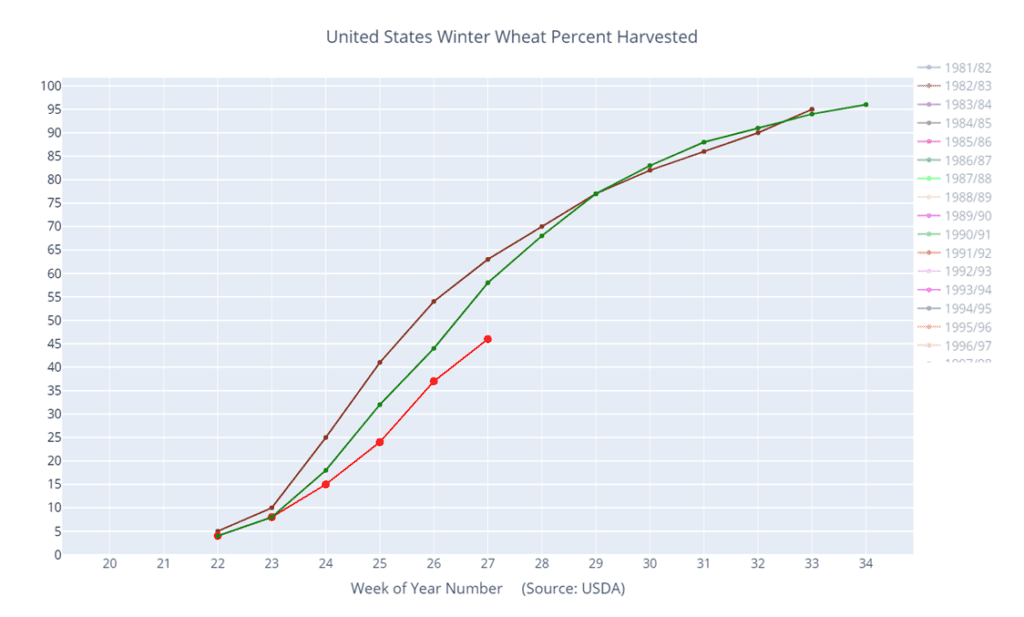
Above: 2023/24 Winter wheat percent harvested (red) versus the 5-year average (green) and last year (purple).
Mpls Wheat Action Plan Summary
- No new action for 2022 Old Crop MINNEAPOLIS Wheat. The market had a nearly 116-cent swing from the May low to the June high and back on weather. While weather and geopolitical events can still affect Old Crop prices, the marketing year for Old Crop is quickly winding down, and any additional upside opportunities may be more difficult to come by before New Crop harvest. Use any remaining bounces in the market to price what Old Crop bushels you may have, if any. We won’t have any “New Alerts” for the 2022 crop (Cash, Calls, or Puts) as we have moved focus onto 2023 and 2024 Crop Year opportunities.
- No action is currently recommended for the 2023 New Crop. Weather dominates the market right now, and though much of the growing season remains, Grain Market Insider suggested making a sale as prices closed below 822 to protect from further downside erosion due to a potential trend change. Seasonally, there isn’t a strong likelihood of higher prices until after harvest, although both weather and geopolitical events can change suddenly to shock the market higher. Insider will consider making sales suggestions if prices improve through this growing season, while also continuing to watch the downside for any further violations of support.
- We continue to hold on pricing the 2024 crop. With the September ‘24 contract about 60 cents from its May 22 low, continued issues in the Black Sea region and major exporting countries’ stocks expected to fall to 16-year lows, we are entering the time frame where we would consider suggesting making sales recommendations while also keeping an eye on the recent lows for any violation of support.

Above: The September contract rallied out of its congestion area on the Front Month Continuous chart towards the 200-day moving average and into resistance between 889 and 940, the April and December highs respectively. With the market off those highs, it will need additional bullish news to be able to trade through them. Should the market continue to fall, support may be found between 770 and 730.
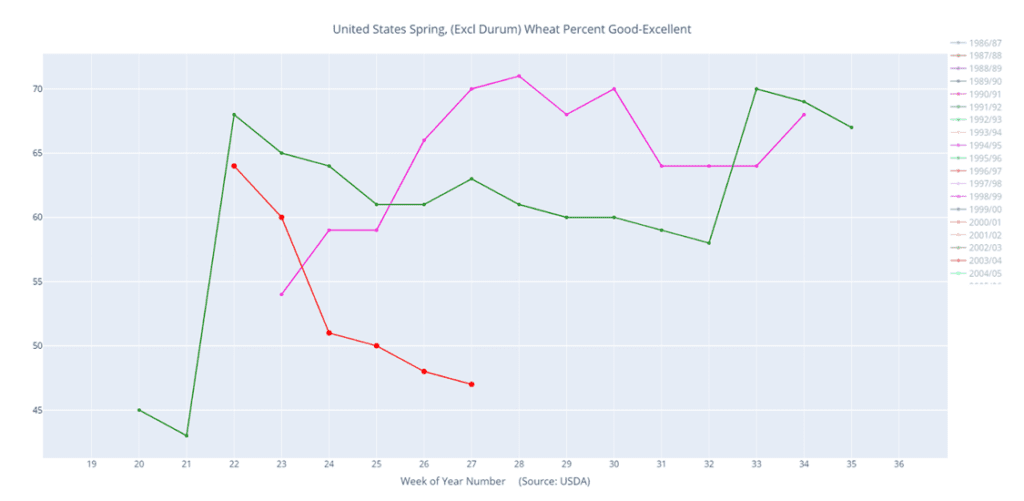
Above: 2023/24 Spring wheat condition percent good-excellent (red) versus the 5-year average (green) and last year (pink).
Other Charts / Weather
